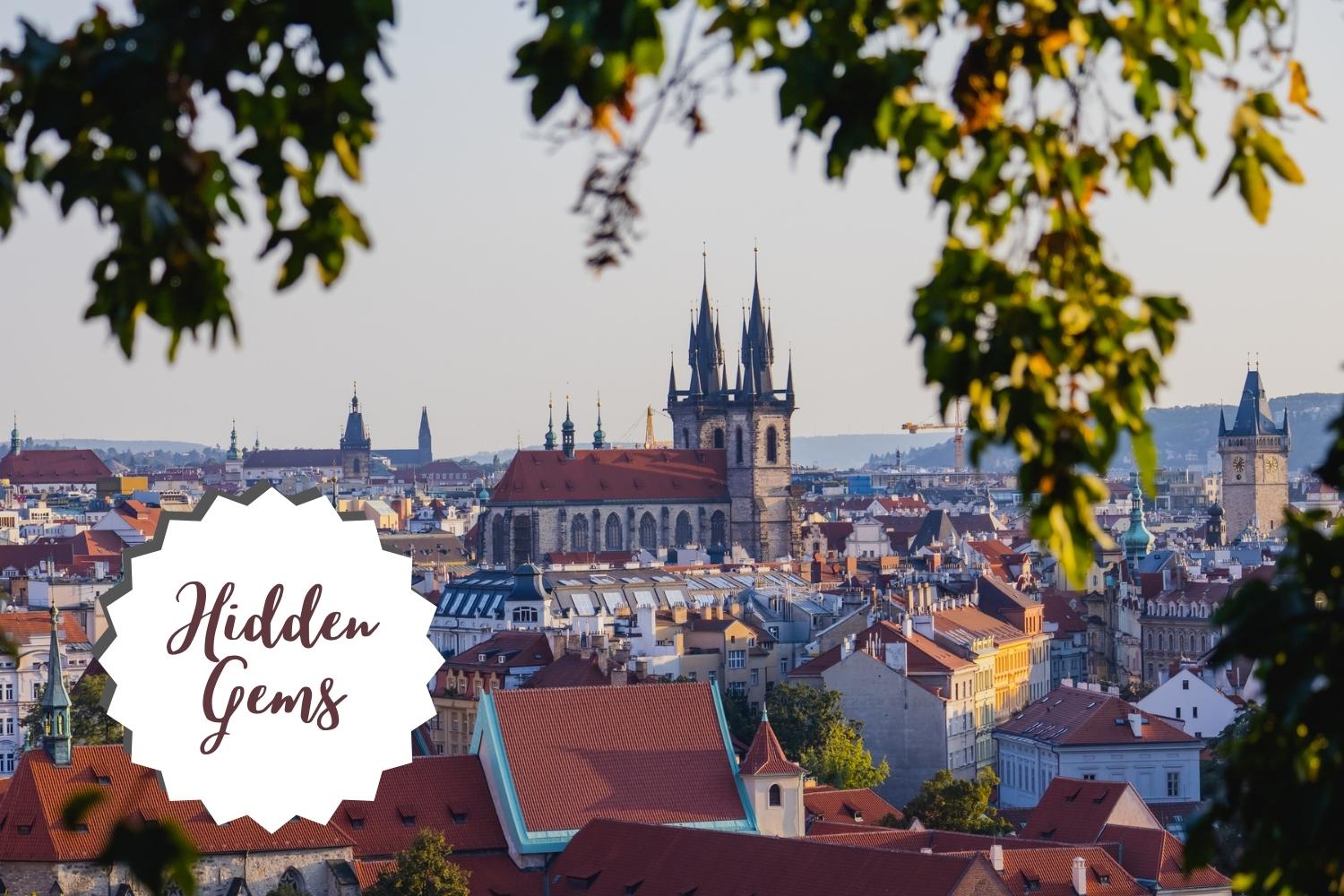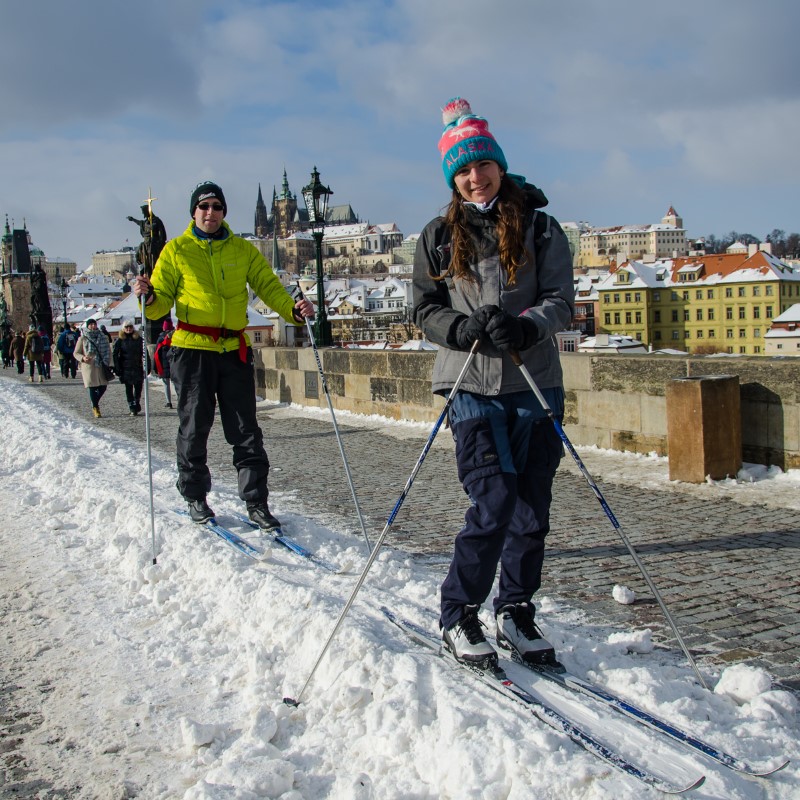
Written by local experts Adriana & Matěj
Adriana and Matěj Halouskovi are travel bloggers behind the successful blog Czech the World.
Matěj was born in Prague and has lived here his entire life and Adriana moved here 6 years ago.
We have traveled to more than 60 countries, but if we could tell you what place we know the most, it is our city.
Prague, the city of a Hundred Spires, is famous for its stunning architecture and deep history. While many tourists flock to well-known spots like Charles Bridge and Prague Castle, the city has much more to offer. As locals, we will take you off the usual tourist path to explore hidden gardens, unique art spaces, and charming neighborhoods!
In this article, we’ll journey through Prague hidden gems that provide a unique, enriching, and decidedly local perspective on this enchanting city.
Map of Prague Hidden Gems
Here we have prepared for you a detailed map of Prague hidden gems.
You can export the map to mobile applications such as Locus Map or Maps.me. This way, you can use the map completely offline!
1) Fanta’s Building of Prague Main Station
Fanta’s Building is an architectural gem that serves as the historical part of Prague’s Main Train Station. Designed by Czech architect Josef Fanta and completed in 1909, the building is a prime example of Art Nouveau architecture. If you just use the station as a transit hub, it is very easy to miss it.
To be honest I didn’t notice this piece of architectural heritage until we were invited to the ball that took place at Fanta’s Hall. If you have a little bit of time, I encourage you to visit café “Fantova Kavárna”, where you can enjoy the atmosphere of an Art Nouveau café and history all around you.
The station is open year-round, but to truly appreciate its architectural beauty, it’s best to visit during daylight hours when natural light illuminates the interior details.
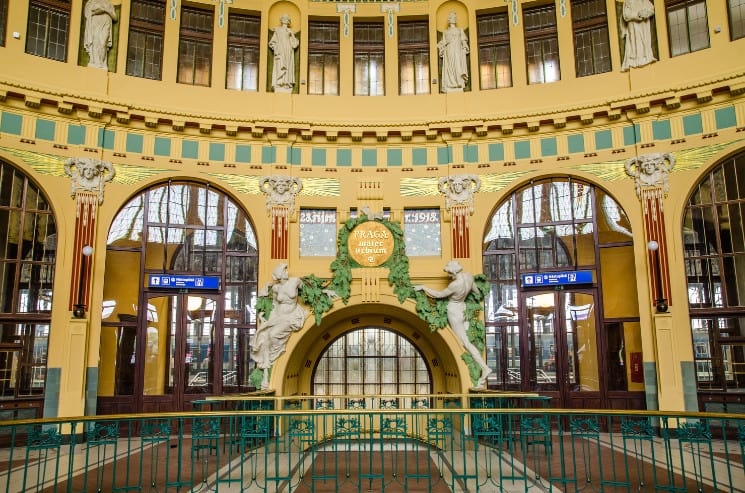
2) Upside-down horse sculpture
David Černý’s Upside-down Horse sculpture in Prague symbolizes rebellion and social commentary, depicting Saint Wenceslas riding an upside-down dead horse. Unveiled by Černý, it has become an integral part of Prague’s art scene, serving as a reminder to question established narratives and engage with Czech history.
The sculpture can be found at Pasáž Lucerna, Vodičkova, 110 00 Nové Město.
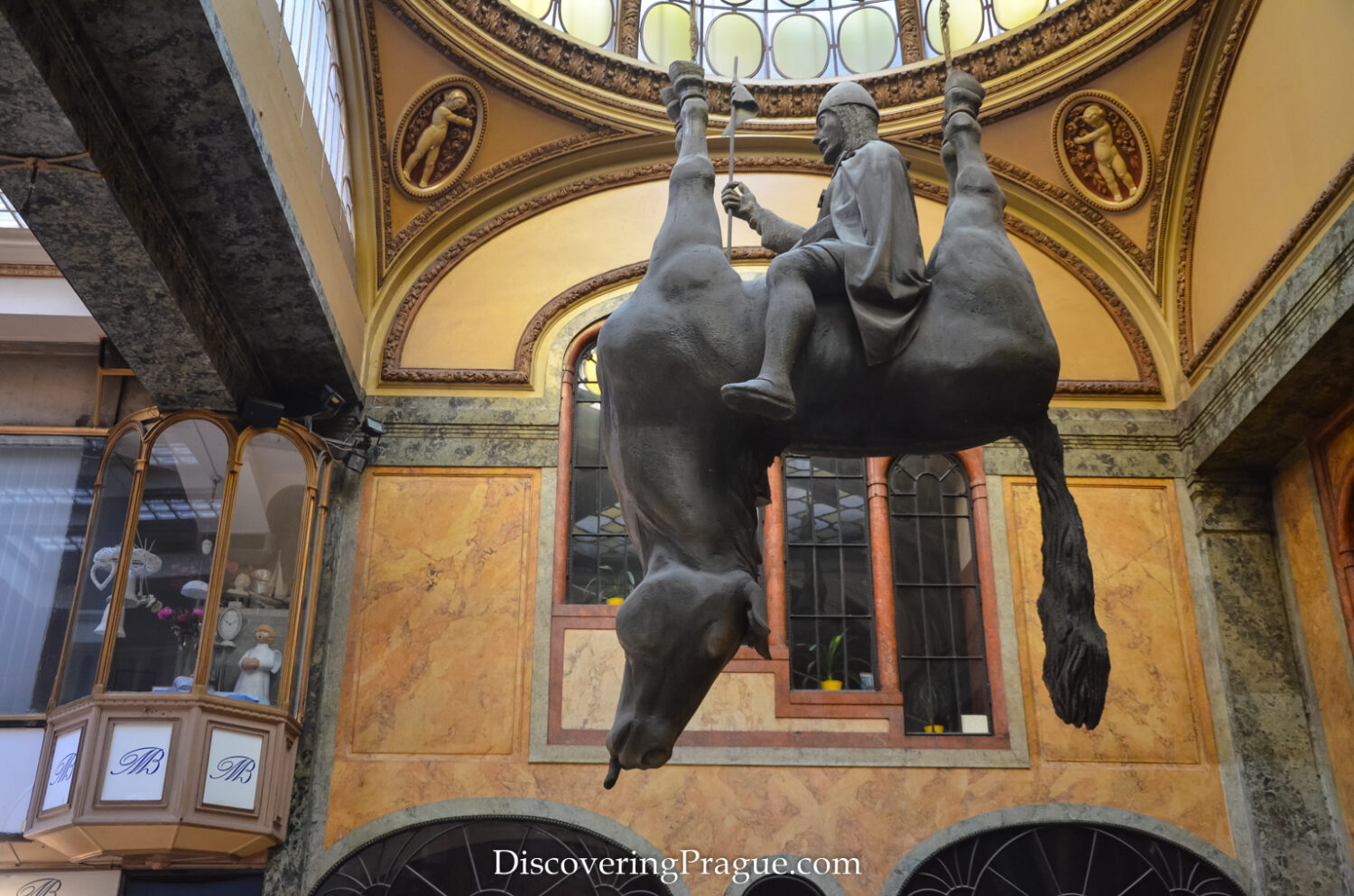
3) Wallenstein Garden (Valdštejnská zahrada): Enjoy the serene atmosphere of the baroque garden
Valdštejnská Zahrada is one of Prague’s first Baroque gardens, established in the early 17th century. It’s a space that locals like me cherish not just for its historical value but also as a tranquil escape right in the heart of the city.
You can admire geometric flower beds and a unique artificial grotto. The bronze statue of Hercules by the pond is must-see.
The garden is at its best in late spring and early summer when the flowers are in bloom. If you’re a classical music fan, look out for summer concerts at the Sala Terrena.

4) Smallest house in Prague (2,25 m wide)
The Smallest House in Prague, located in the Lesser Town, is a charming curiosity that adds to the city’s eclectic architectural landscape. I find it fascinating how this tiny structure, with a width of just 2.25 meters, has stood the test of time and urban development. The interior is not usually accessible, but the exterior alone is worth a visit.
I’d say the Smallest House is a must-see not just for its size but for what it represents—a slice of Prague’s diverse and sometimes eccentric history.

5) Faceless Baby Statues
Situated on Kampa Island, nestled between the iconic Charles Bridge and the Vltava River, Kampa Park offers a serene escape in the midst of Prague’s bustling city life. It’s a perfect spot to relax, with its sprawling green lawns, tranquil water channels, and picturesque views of the city’s historic architecture. One of the park’s most distinctive features is the installation of faceless baby statues by Czech artist David Černý. These intriguing, larger-than-life sculptures, which appear to be crawling on the ground, have become emblematic of Kampa Park and provide both a unique photo opportunity and a taste of Prague’s contemporary art scene.
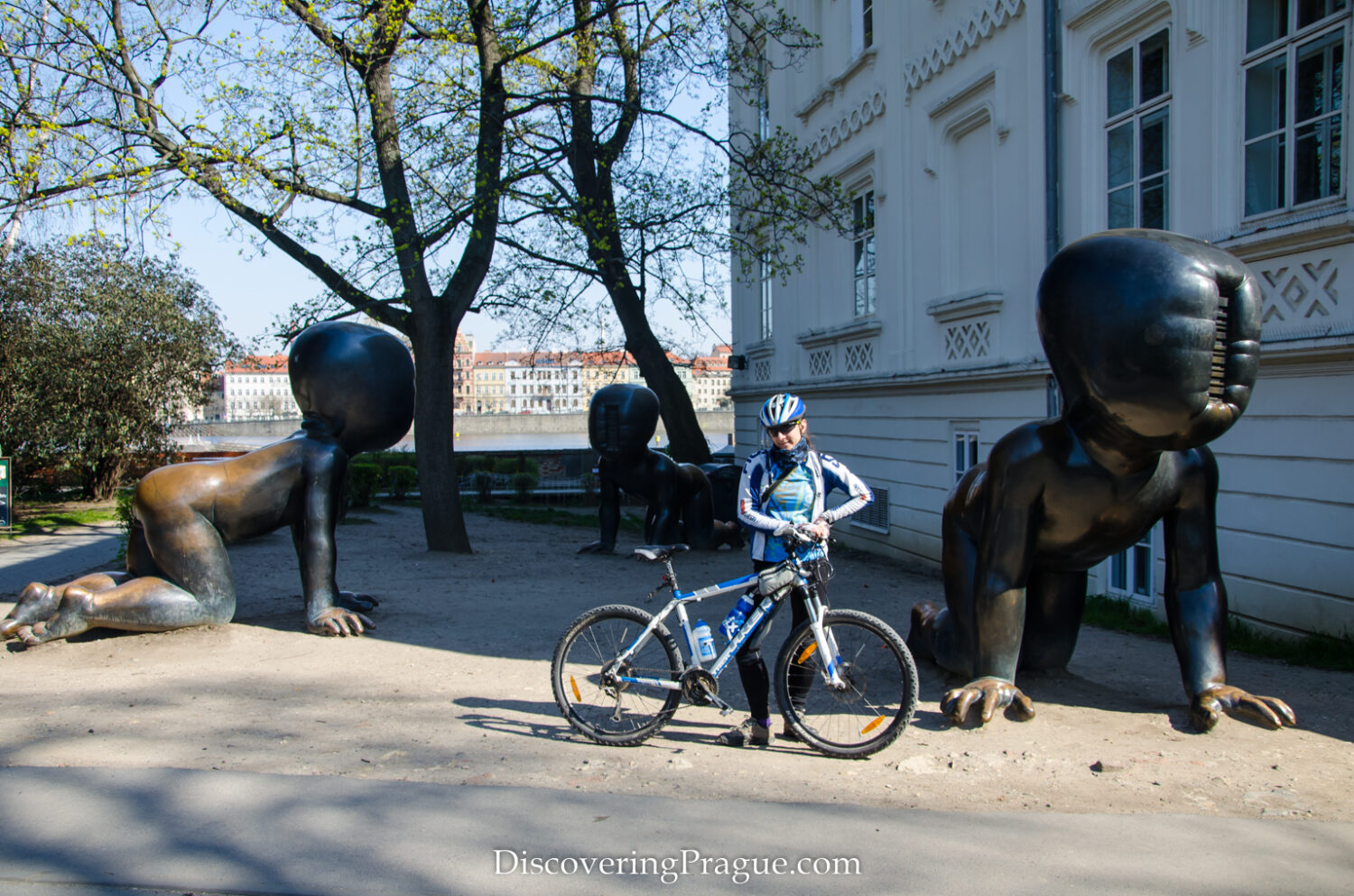
6) Prague House Signs
House signs in Prague are unique emblems that adorn many of the city’s historic buildings. As a local, I see these signs as more than just decorative elements; they are a window into the city’s past, often dating back to times when houses didn’t have numbers. Each sign tells a story, whether it’s about the profession of the original owner, the history of the building, or local legends.
The signs come in various forms—some are painted, while others are sculpted or engraved. They often depict animals, objects, or historical figures. Notable examples can be found in areas like Lesser Town and Old Town. One famous sign is “The Three Fiddles” in Lesser Town, which marks the home of a family of renowned violin makers.

7) Cross Club Holešovice
Cross Club, located in the Holešovice district, is a visual experience, featuring intricate mechanical installations, rotating gears, and vibrant lights. This venue is a mecca for those interested in alternative music, art, and social events. Its steampunk-inspired design sets it apart from any other venue in the city.
It offers multiple stages that host a variety of events, from electronic music to live bands and theater performances. The outdoor garden is a relaxed space for conversations and also features smaller art installations.
Weekend nights are the most vibrant, with a diverse lineup of events, but they can also be crowded. If you prefer a quieter experience to appreciate the art and design, weekday evenings are a good option
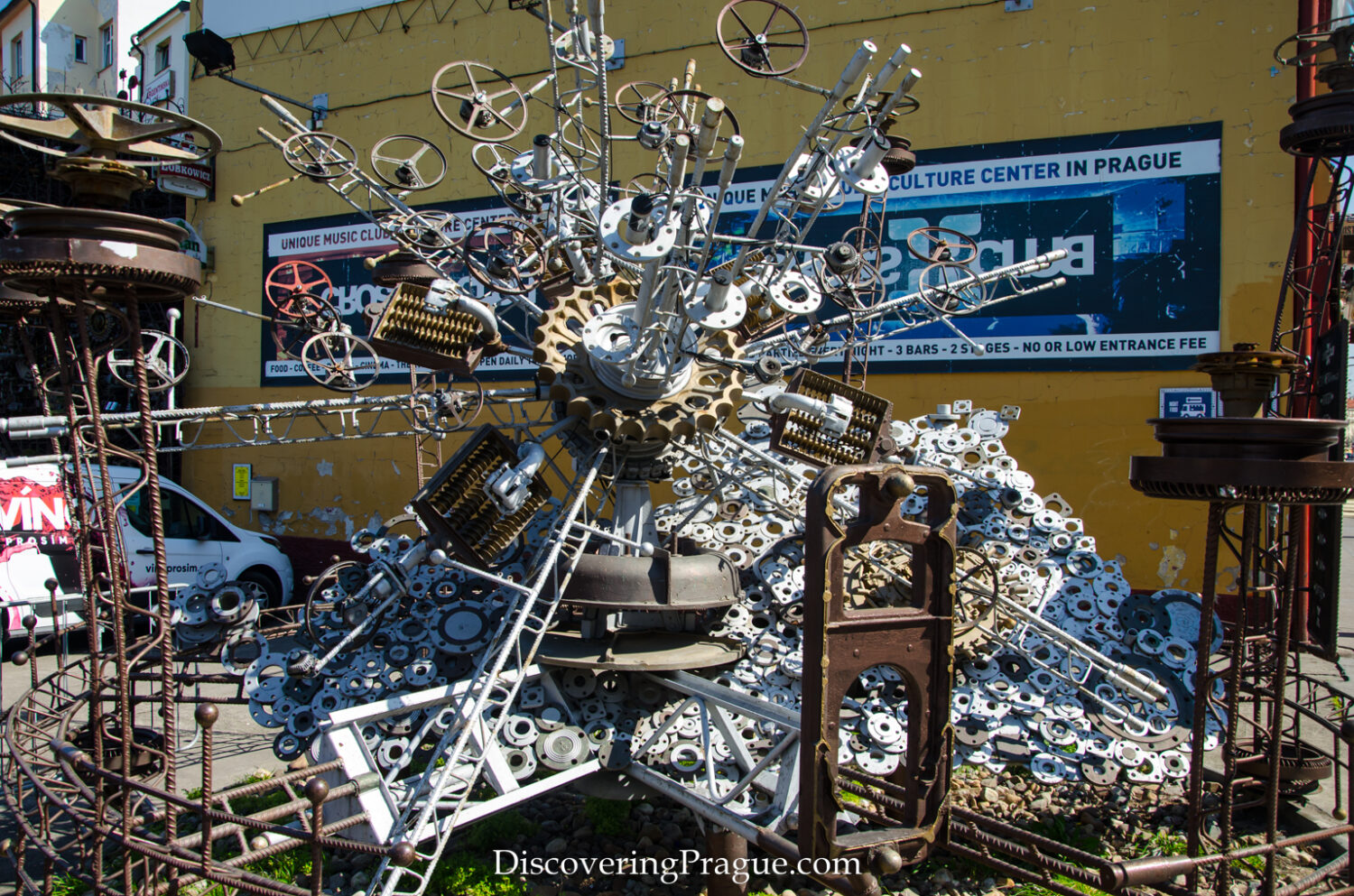
8) Provocative Piece “Brown-nosers”
Located in the courtyard of the Futura Gallery in Smíchov (Holečkova Street), this sculpture by David Černý is a provocative piece that challenges conventional norms and sparks debate. As a local, I find it to be a compelling example of Prague’s edgy contemporary art scene.
The sculpture features a giant lower human torso where visitors can climb a ladder and stick their heads into the rear end to view a video playing inside. It’s a bold statement on political sycophancy and the nature of power. The experience is as unsettling as it is thought-provoking.
9) The narrowest alley in Prague
The nameless street leading from “U Lužického semináře” Street to the garden of the Čertovka restaurant, is so narrow that a traffic light needed to be installed. It stands as the last remaining fire alley in Malá Strana. It is the last remaining fire alley in Malá Strana.
Measuring a mere 50 centimeters (19.7 inches) at its narrowest point, this street stands as a quirky and delightful treasure that fascinates both locals and visitors alike.
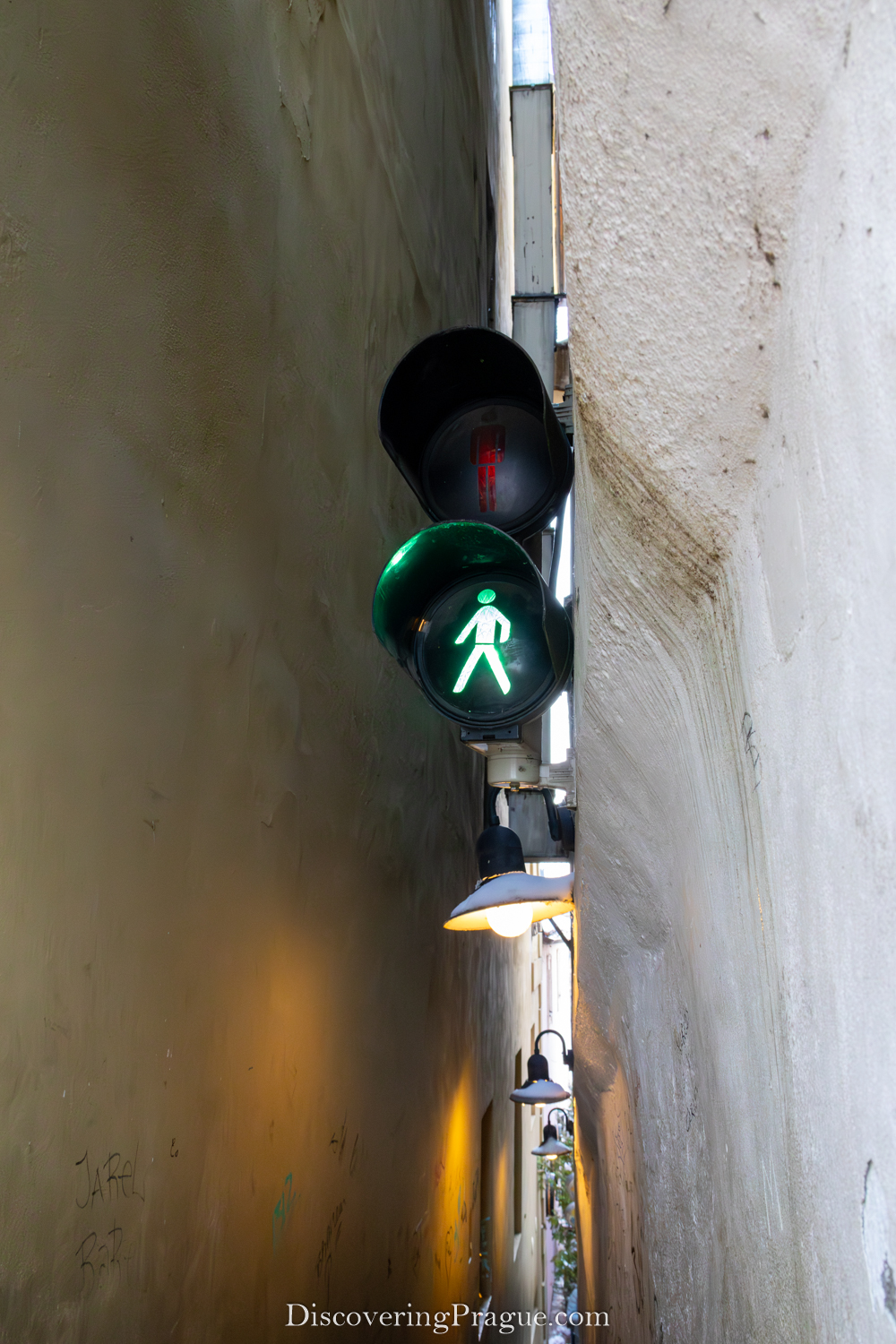

10) Emmaus Monastery (Emauzský klášter)
The Emmaus Monastery is one of Prague’s oldest and most historically significant religious sites. Founded in the 14th century, it’s unique for being one of the few places where the Slavonic liturgy was performed. The monastery has survived various historical events, including a bombing in World War II.
The monastery is open to visitors year-round, but the best time to go is during the spring and summer when the garden is in full bloom. If you’re interested in religious ceremonies, check the schedule for any special services or events.
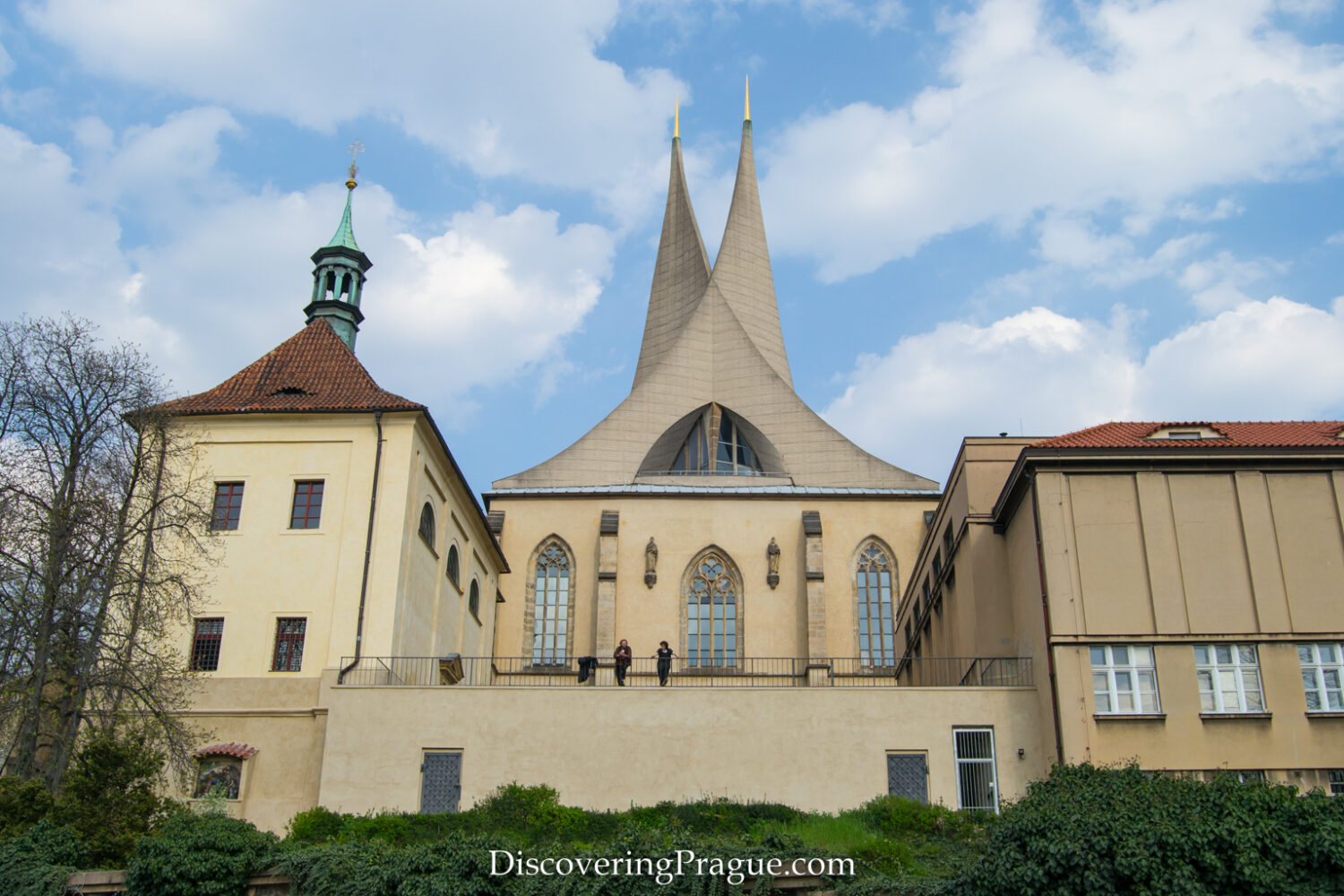
11) Beer Spa
Beer Spas in Prague offer a unique wellness experience that taps into the Czech Republic’s rich beer culture. As a local, I can attest that beer is more than just a popular beverage here; it’s a part of our national identity. Well, they had to make a law that there needs to be at least one non-alcoholic beverage cheaper than beer in every pub… 🙂
The Beer Spa takes this cultural affinity to the next level by offering therapeutic treatments that utilize beer’s natural ingredients.
A typical Beer Spa experience includes soaking in a wooden tub filled with warm water, beer, hops, and yeast. While you relax, you can often enjoy unlimited beer from your own personal tap. Some spas also offer additional treatments like beer massages or hops saunas. It’s a unique way to unwind and enjoy the benefits of beer without actually drinking it—although you can certainly do that too!
Book here: Beer Bath with Unlimited Bernard Beer in Czech Republic
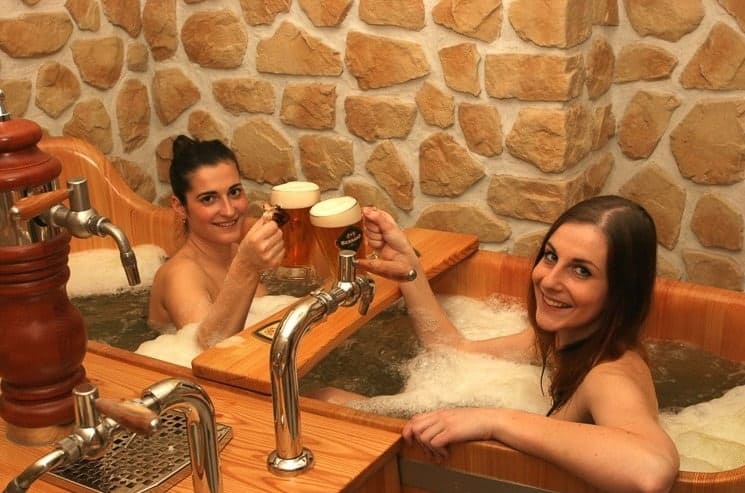
12) Trója Chateau: Explore the chateau’s courtyard
Troja Chateau, a hidden gem nestled on the outskirts of Prague, offers a captivating blend of history and nature. The main highlight is its stunning courtyard, which boasts well-manicured gardens and a Baroque fountain that make for a picture-perfect setting. Visitors can explore the exterior of the chateau for free, soaking in the architectural beauty of this 17th-century marvel. The chateau is also home to the Prague City Gallery’s Collection of Old Masters, although entrance to the gallery itself may require a fee.
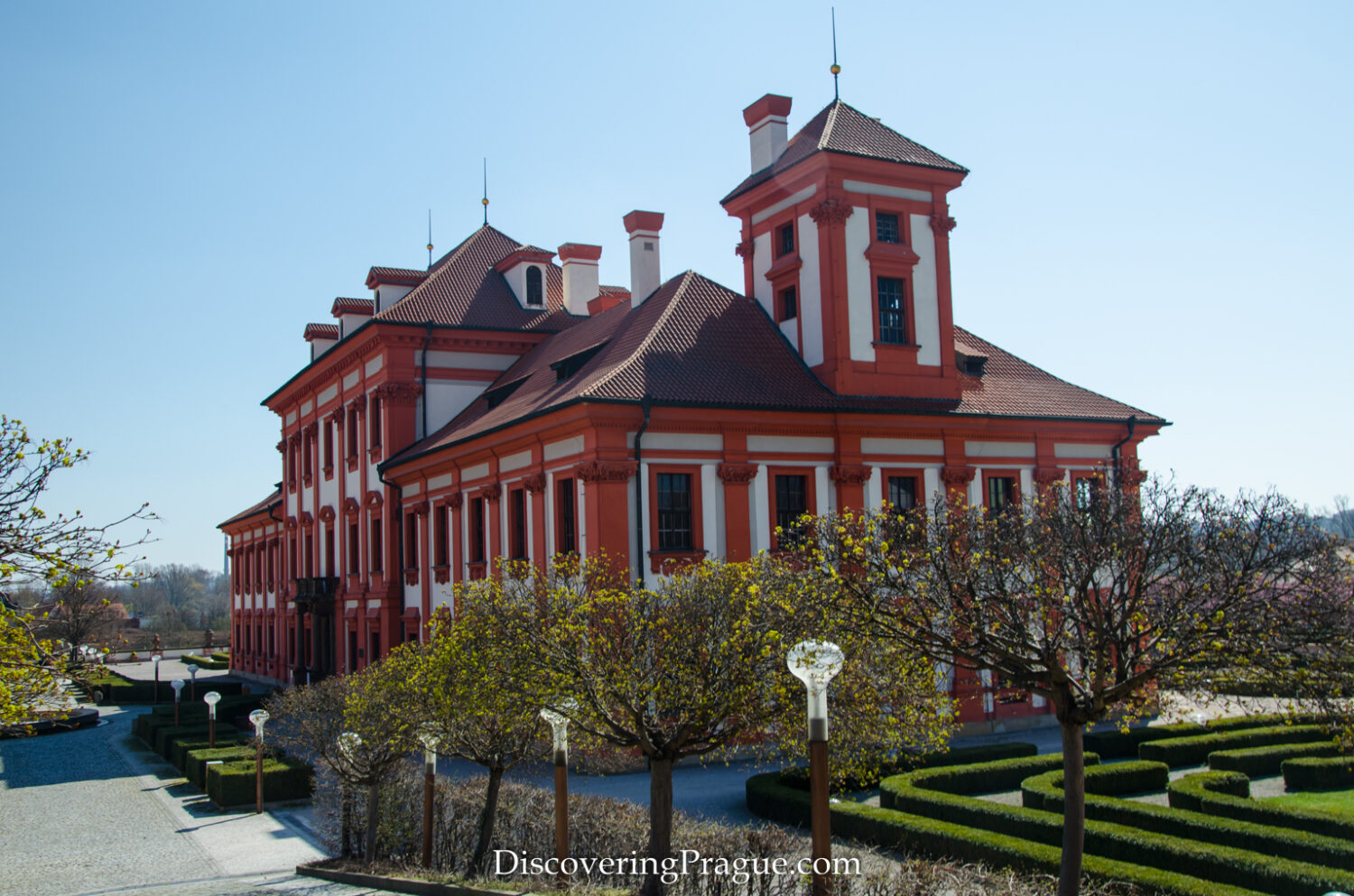
13) Nový svět (New World)
Nový Svět is a quaint and historic neighborhood located near Prague Castle. This area nearly has the ability to transport visitors back in time.
Historical celebrities, such as the Danish astronomer and mathematician Tycho Brahe and Jan Kepler, also resided here. One of the houses called “U zlatého žaludu” (At the Golden Chestnut), belonged to the Santin family, which produced several prominent artists and architects.
The neighborhood is characterized by its narrow, winding streets, small houses, and charming courtyards. One of its most iconic spots is Nový Svět Street, lined with picturesque cottages. It’s a photographer’s dream and a perfect place for a leisurely stroll.
Nový svět is particularly enchanting in the spring and autumn when the foliage adds to its charm. Early mornings or late afternoons are ideal for capturing the best light for photos.

14) Mrázovka Funicular of Hotel NH Praha
The ground funicular at NH Prague Hotel in Prague’s Smíchov district connects two hotel buildings via Mrázovka Park. It’s free for both hotel guests and the public, offering access to a restaurant in the upper building. The funicular started trial operations in March 1996 and regular operations in June 1996.
Technical Details:
- Length: 156 meters
- Elevation: 51 meters (205–256 meters above sea level)
- Maximum Speed: 2.5 m/s (9 km/h)
- Travel Time: 90 seconds”
15) Obora a letohrádek Hvězda
Letohrádek Hvězda, located at Bílá Hora near Prague, is a historical site with a hexagram-shaped structure symbolizing harmony. It was built in the 16th century by Ferdinand Tyrolský and served as a hunting lodge. Over time, it had various uses, including gunpowder storage and a museum. Today, it houses the National Memorial of Czech Literature.
The surrounding area, once a hunting ground, is now a peaceful place for walks, relaxation, and outdoor activities. Letohrádek Hvězda is a designated national cultural monument.

16) Paternoster Elevator
The Czech Technical University in Prague (ČVUT) offers visitors and students an intriguing mechanical adventure in the form of its paternosters. These continuously moving elevators, reminiscent of a bygone era, consist of a chain of open compartments that move slowly in a loop without stopping, allowing passengers to hop on and off at their desired floor. A rarity in modern buildings due to safety standards, the paternosters at the Czech Technical University provide a unique blend of history and engineering marvels. They can be found at FEL a FS, Technická 2 and 6, Praha 6.
Good thing is that you don’t need to visit directly ČVUT because there are more than 30 of them in Prague. The most famous one is in Prague City Hall (Mariánské náměstí 2).
17) Prague’s Náplavka Waterfront
Located along the Vltava River, Pražská náplavka is a popular destination for both locals and tourists. Local underground spaces (kobky), originally used for storing materials brought in by ships, have been renovated and repurposed, reflecting Prague’s ability to adapt and modernize.
Nowadays, instead of dark and gloomy tunnels, these kobky have been transformed into vibrant and lively venues, including galleries, bars, and cafes. As you descend into the depths, you’ll be greeted by a world of creativity and innovation, where art, music, and good company come together.
I can highly recommend these spaces whether you want just to chill by the river or explore a new corner of Prague.

18) Experience Medival Times at the Tavern of King Brabant
It’s not just about the food it’s about the experience! The tavern goes beyond serving meals; it offers an immersive medieval experience. Diners eat by candlelight, often using their hands in line with medieval customs. The staff are dressed in period costumes, and the interior is decorated with medieval artifacts. The experience is often enhanced by live performances, including sword fights, fire shows, and live medieval music.
I recommend visiting some of their evening programs. Each evening offers a different show, so you may want to check the schedule to align with your interests.
19) Zlatá ulička (Golden Lane)
I guess, you are not going to miss Prague Castle, but once you are there, don’t miss Golden Lane (it is located on the other side of the Prage Complex than the guards are).
Golden Lane is a historic street lined with colorful, tiny houses. It is a symbol of Prague’s rich history, from its origins as a lane for castle guards to its later years as a residence for goldsmiths, and alchemists.
Its small, colorful houses now serve as shops, museums, and exhibition spaces. House No. 22 is particularly notable as it was briefly the home of writer Franz Kafka.
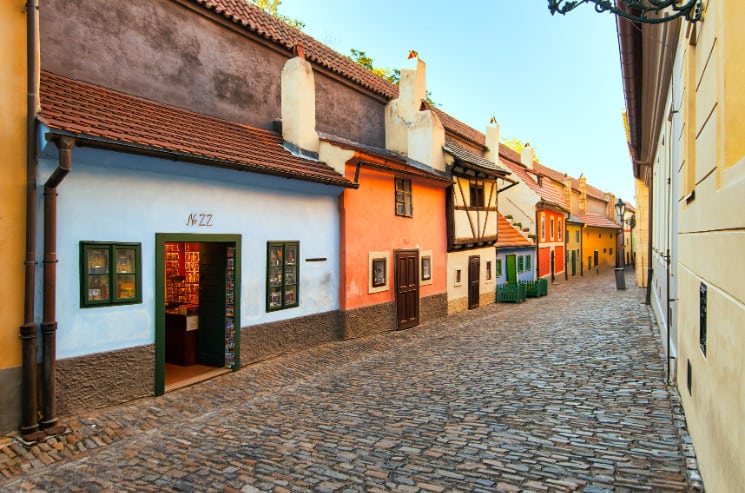
20) Františkánská Zahrada (Franciscan Garden): Relax in this hidden garden
Františkánská Zahrada is a hidden gem tucked away in the heart of Prague. This peaceful oasis offers a respite from the city’s bustling streets, with shaded pathways, colorful flowers, and a serene atmosphere. It’s an ideal spot for a quiet escape, a leisurely read, or a peaceful moment of reflection.
The garden is open every day year-round, but it’s particularly beautiful in the spring when the flowers are in bloom.
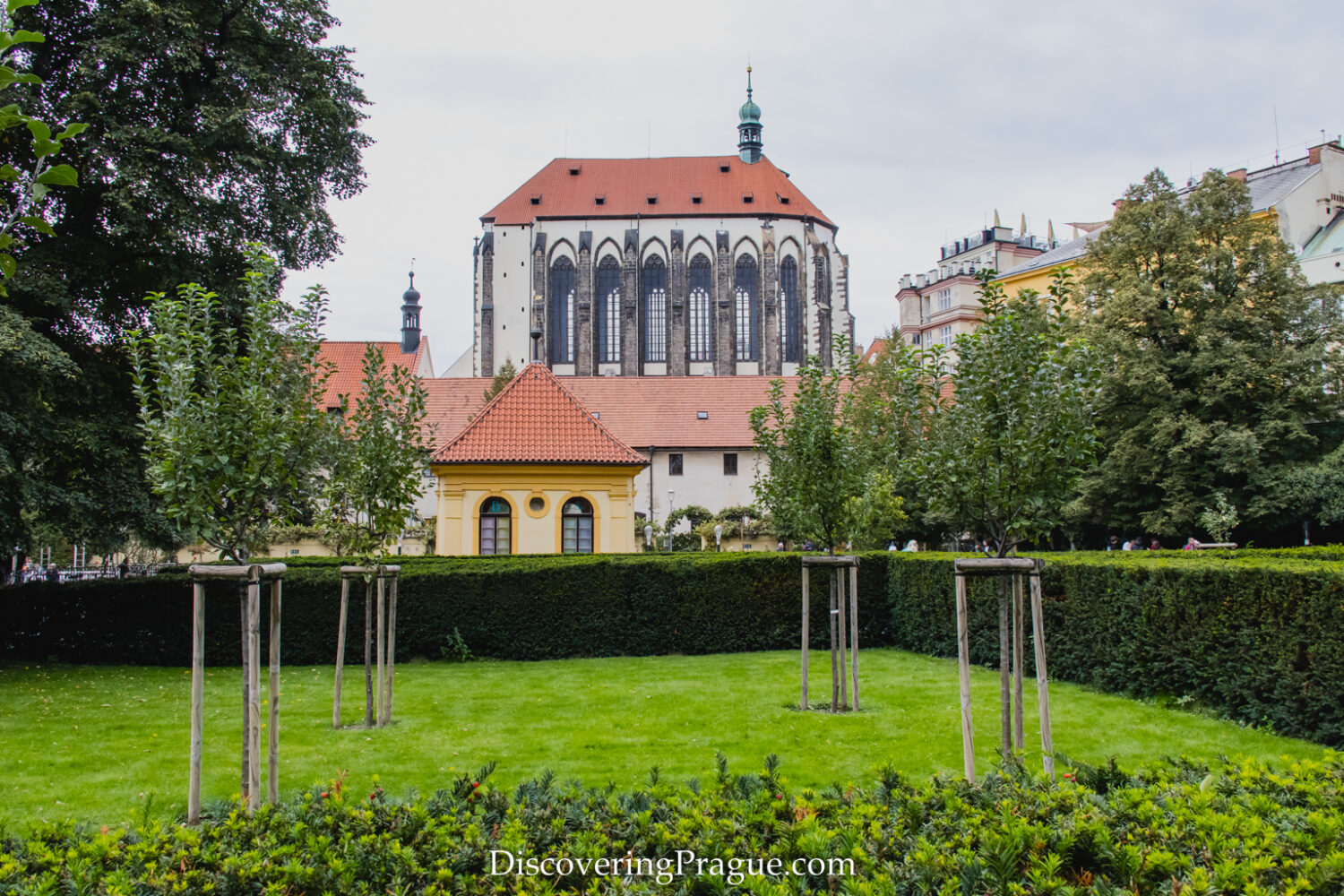
21) Náměstí Míru: Explore this peaceful square
Náměstí Míru, or Peace Square, is a tranquil oasis amidst the vibrant city of Prague. Adorned with elegant buildings and featuring the stunning Neo-Gothic Church of St. Ludmila, the square offers a serene escape from the urban hustle. Visitors can relax on benches, watch the world go by, or simply appreciate the architectural beauty that surrounds them.
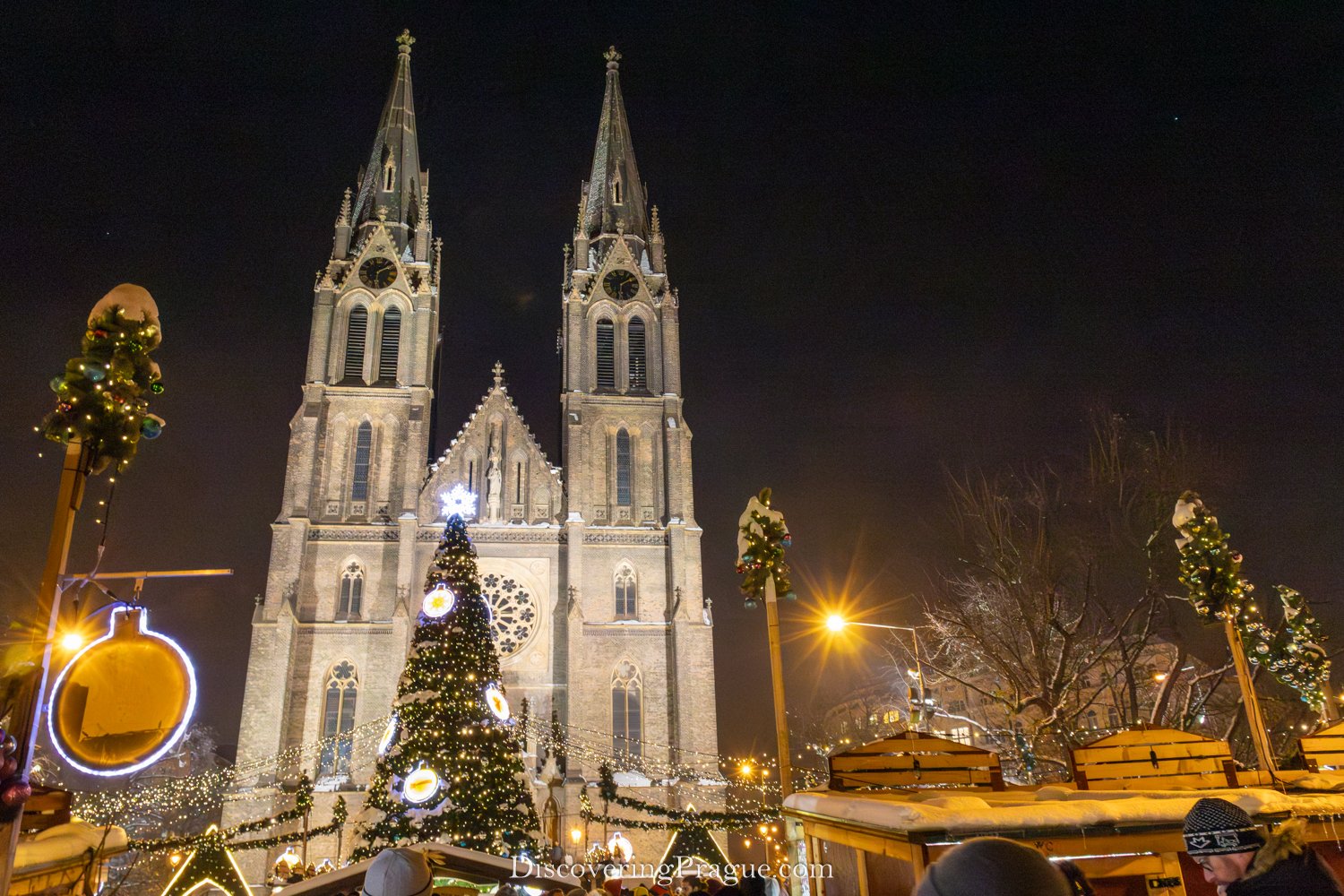
22) Strahov Library
Located within the Strahov Monastery, the Strahov Library is one of the oldest monastic libraries in the country. As a local, I see this library as a treasure trove of knowledge, art, and history. It’s not just a collection of books; it’s a testament to the intellectual and cultural heritage of Prague.
There are 2 main halls: the Theological Hall and the Philosophical Hall. Both are stunning examples of Baroque architecture, featuring intricate woodwork, frescoes, and historical globes. The Theological Hall houses ancient religious texts, while the Philosophical Hall contains a broader range of subjects.
The library is open to the public, but it’s best to check the opening hours in advance as they can vary. Early mornings or late afternoons during weekdays are generally less crowded, offering a more intimate experience.
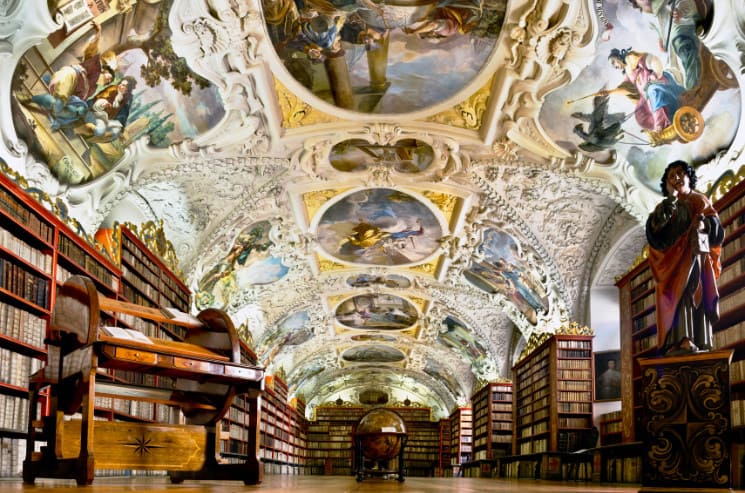
23) Pragulic Tours
Pragulic is a social enterprise that offers tours led by former homeless individuals. I think it is a great idea that helps people get back to life.
The tours cover various parts of Prague and focus on the experiences and stories of the guides, who were once homeless. These narratives offer a different lens through which to view the city, touching on social issues, hidden spots, and personal stories that you won’t find in conventional tours. The initiative also serves as a form of employment and empowerment for the guides.
You can book the tour and help by joining it here. It’s advisable to book in advance due to the limited number of spots. Each tour has its own focus and duration, so you can choose one that aligns with your interests and schedule.
24) Prokopské údolí + Děvín viewpoint
Prokopské údolí is a natural valley located in the southwestern part of Prague, specifically in the city districts of Prague 5 and Prague 13. This valley is renowned for its natural beauty and recreational opportunities.
The Děvín viewpoint offers a magnificent view of the surrounding landscape and is a popular destination for tourists and nature enthusiasts. From this vantage point, you can admire a panoramic view of Prague, the Vltava River, and the surrounding forests.
Prokopské údolí is ideal for hiking, cycling, and enjoying the outdoors, all within a short distance from the bustling center of Prague. This location provides an opportunity to escape the urban hustle and enjoy the tranquil atmosphere of nature.

25) Old Bubeneč Sewage Treatment Plant
For now, let’s skip the medieval times, this building gives us insights into early 20th-century urban planning and engineering.
Built between 1901 and 1906, this sewage treatment plant is a significant document of architectural, engineering, and water management history in Prague. It was designed by British engineer Sir William Heerlein Lindley and served its original purpose until 1967.
You can explore this historic Wastewater Plant with a guided tour at weekends and public holidays.
26) Two peeing Figures Statue: A combination of humor, art, and provocation
Just outside the Franz Kafka Museum in the Malá Strana district, visitors often find themselves amused and intrigued by the „Peeing Figures“ statue. Crafted by the ever-controversial Czech artist David Černý, this sculpture features two male figures standing atop a map of the Czech Republic, with a dynamic water mechanism that makes it appear as though they are urinating onto the country.
The figures‘ pelvises and hips move, creating a whimsical, if not irreverent, display as they „write“ quotes from famous Prague residents with their streams. You can also have some of your own words written if you send a text message to a special number (listed by the sculpture).
While the statue’s playful nature often elicits chuckles from passersby, it’s also an invitation to reflect on the deeper commentary Černý may be making about the nation’s political and cultural landscape.
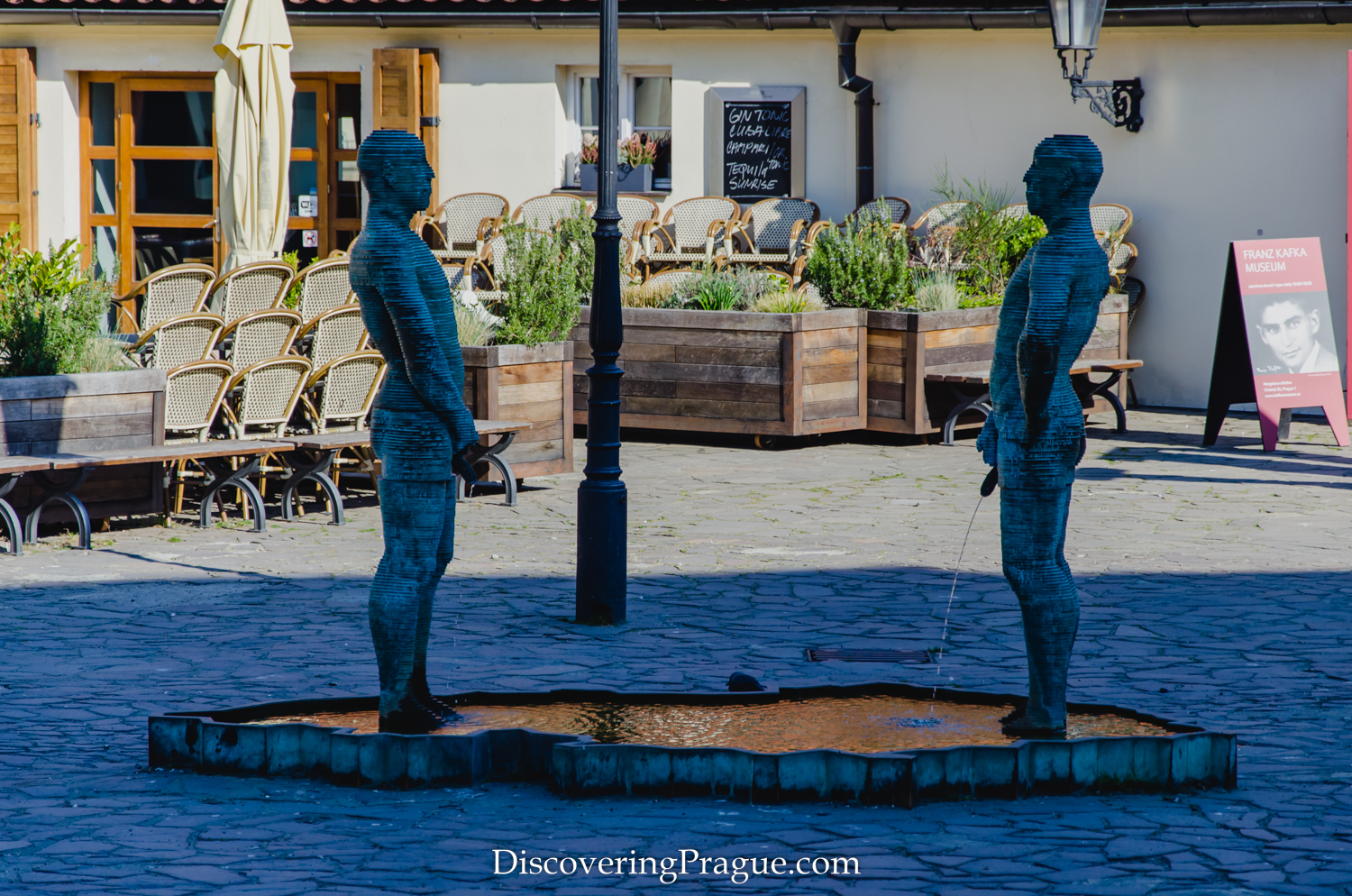
27) Klementinum Library
Although Klementinum is located in the historical city center, people often forget to visit its interiors. The Klementinum Baroque Library is one of the most beautiful libraries in the world.
The library’s main hall is a work of art, featuring intricately carved wooden shelves, stunning frescoes on the ceiling, and antique globes and astronomical instruments. The collection includes a wide range of historical texts, some of which are displayed in rotating exhibitions. It is also known for its beautiful Baroque Library Hall, which is often cited as one of the most stunning libraries in the world.
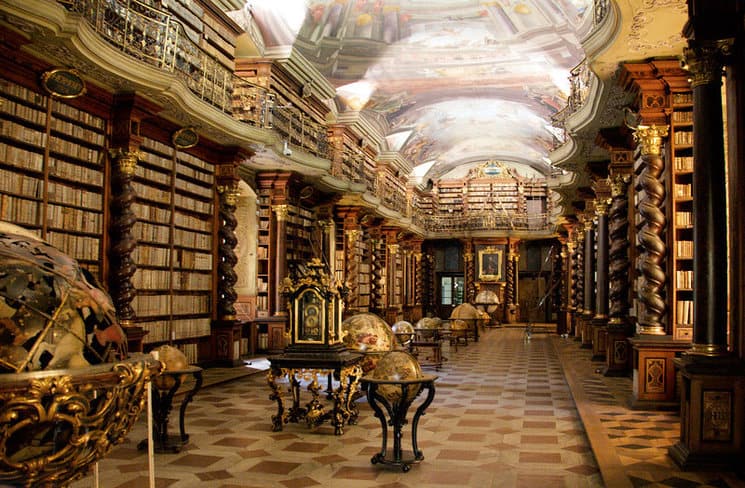
28) Havlíčkovy Sady – Park Grébovka
Havlíčkovy Sady, also known as Park Grébovka, is a picturesque park located in the Vinohrady neighborhood. The main highlight is its serene and romantic atmosphere, characterized by lush greenery, beautiful fountain, vine-covered pavilions, and meandering paths. Visitors can explore this park for a relaxing day, complete with charming gardens, and quiet corners perfect for leisurely reading. The park is home to the Grébovka Pavilion, a Neo-Renaissance gem, which houses a lovely café where you can enjoy refreshments while taking in the park’s beauty.
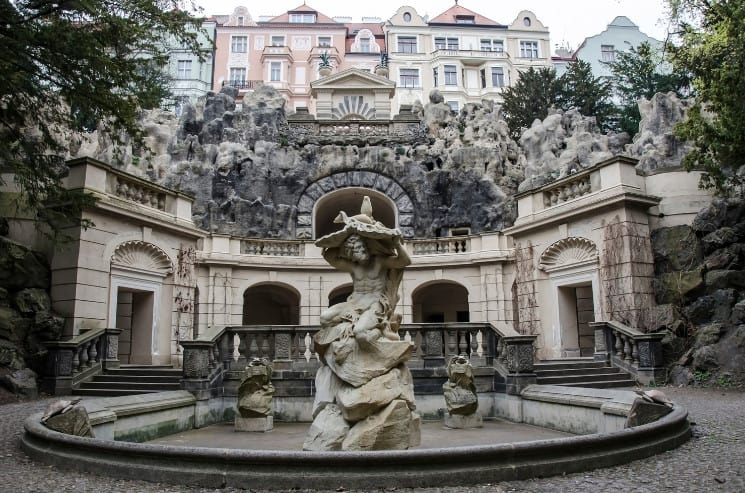
29) Doubravka XIV Lookout Tower at Černý Most
Designed by architect Martin Rajniš, this 23.5-meter-high lookout tower is located in the natural park of Čihadla in Prague 14.
The tower is constructed from three massive legs made of bent acacia wood. A total of 98 steps lead to its top platform, which is situated at a height of 20 meters. The tower is crowned by a 3.5-meter-high flag, adding to its distinctive appearance. From the top, you can enjoy panoramic views of the surrounding natural park and beyond.
30) Cubist Lamp Post: See this unique piece of art
The Cubist Lamp Post is a unique piece of art and architecture that adds a touch of artistic flair to Prague’s streets. Located near the House of the Black Madonna in Prague’s Old Town, the lamp post exemplifies the Cubist movement’s geometric shapes and artistic vision. It’s a small yet intriguing artistic detail that enriches the city’s streetscape.
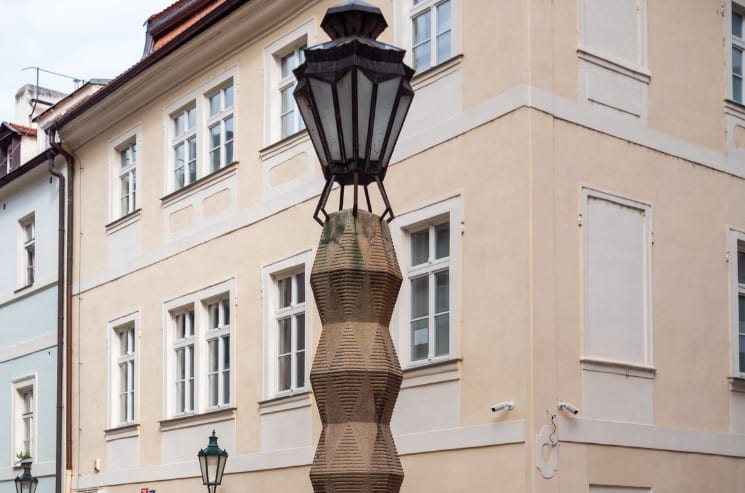
31) Visit “The Pub” to Enjoy Self Service Beer Experience
The Pub offers a unique and interactive drinking establishment. You will love it! Why?
Each table there is equipped with its own beer tap. Which means you can pour your own pints of beer right at the table!
The Pub even has a real-time leaderboard that tracks the amount of beer poured at each table, which may add a competitive element to the evening.
I encourage you to visit this pub especially if you travel with a group of friends, it’s fun.
32) Signal Festival: The Festival of Light
Signal Festival Praha lights up the Czech capital in a blaze of innovative art and technological brilliance. As one of the most significant and anticipated cultural events in the Czech Republic, this annual festival transforms Prague into an immersive canvas for international and local artists to showcase their work in light art and emerging technologies.
From luminous sculptures to interactive installations and thought-provoking projections, the Signal Festival is more than just a display of lights; it is a celebration of creativity at the intersection of art, technology, and the urban environment. Find out more at Signal Festival’s official website.
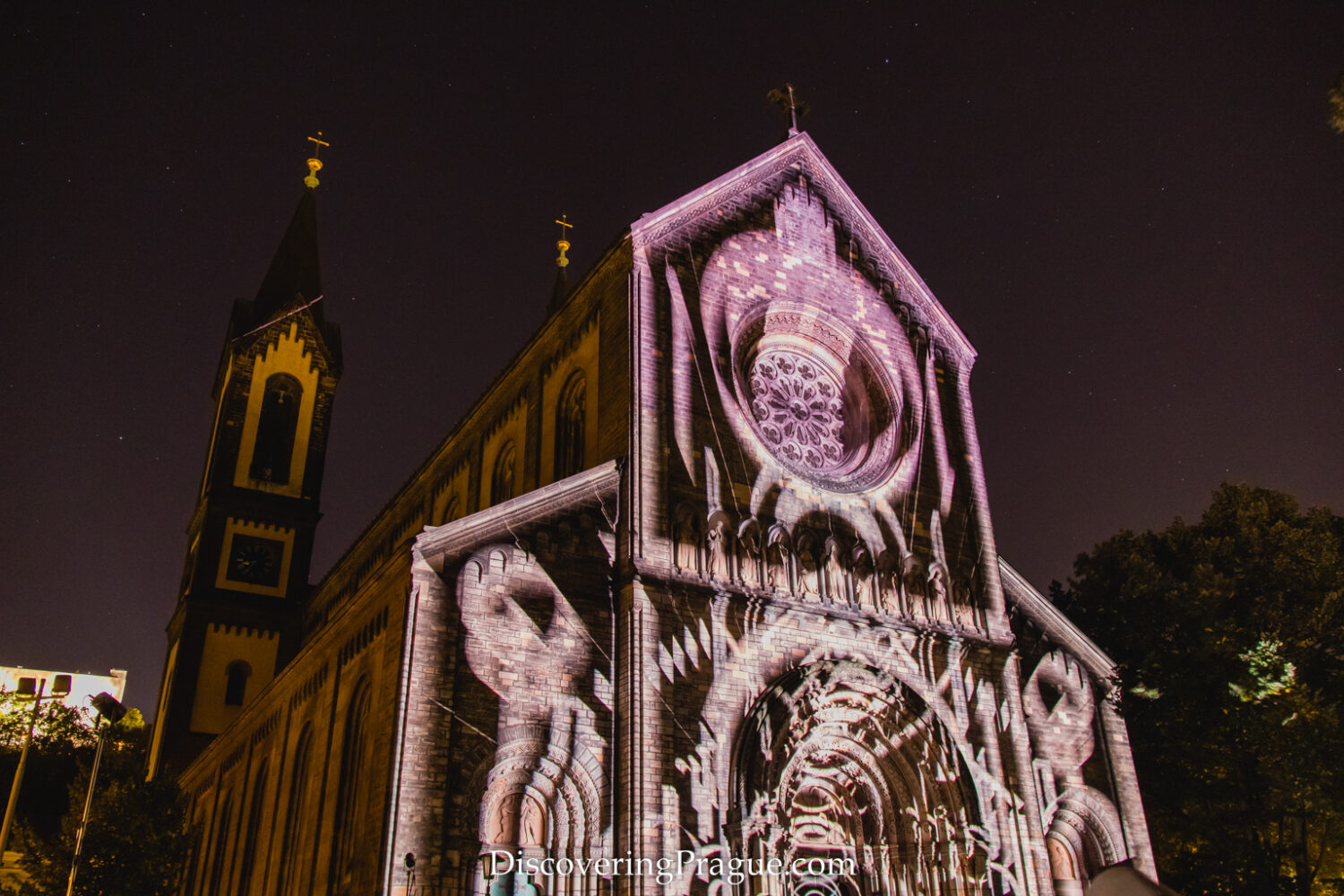
33) The Rotunda of the Finding of the Holy Cross
The Romanesque Rotunda of the Holy Cross, located at the intersection of Konviktská and Karoliny Světlé Streets in Prague’s Old Town, is the city’s oldest surviving Romanesque rotunda from the 11th century.
Legend tells of its origin on the site where a crucified girl was miraculously found above a pond’s surface, leading to the rotunda’s establishment.
Today, it serves as a parish church for the Old Catholic Church and remains a significant historical and religious landmark in Prague’s Old Town.
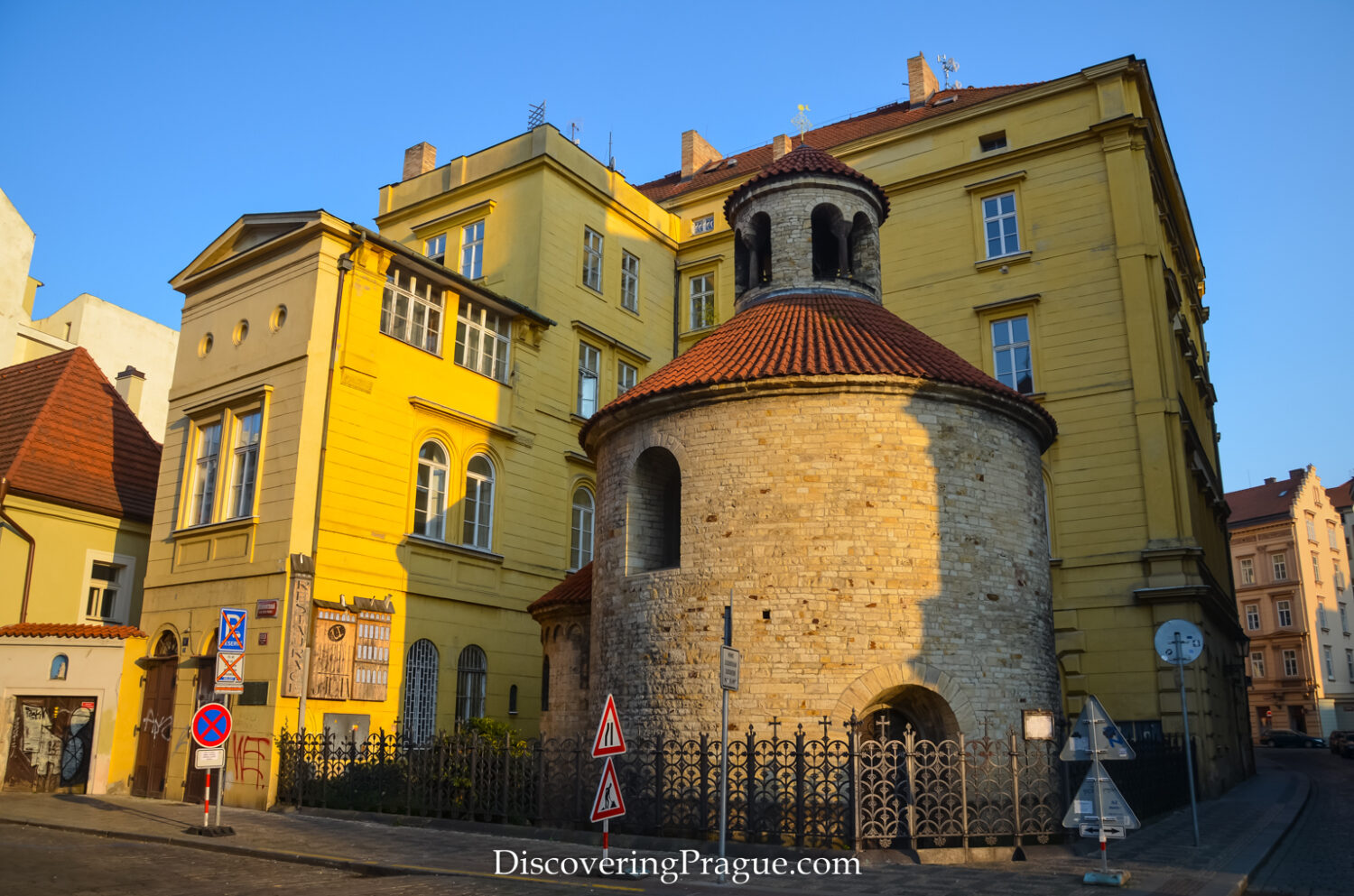
34) The Museum of Alchemists and Magicians of Old Prague
Located in the heart of Prague, this museum delves into the mysterious world of alchemy and magic that was once an integral part of the city’s history.
The museum features a series of exhibits that take you on a journey through the lives and works of famous alchemists and magicians who once resided in Prague. It includes replicas of alchemical laboratories, magical artifacts, and interactive displays. One of the highlights is the story of Edward Kelley, an English alchemist who was a key figure in Rudolf II’s court.
Find out more at Mysteria Pragensia.

35) Prague Meridian
The Prague Meridian is a line marked on the cobblestones of Old Town Square that has served as the local reference for solar noon since 1652. It was historically used to determine solar noon based on the shadow cast by the Mariánský Sloup, or Marian Column, located in the square.
It’s easy to overlook but offers a unique opportunity to engage with Prague’s history. In the past, the meridian was used to set the time for the city, and a nearby building even features a small cannon that was fired daily when the sun crossed this line.
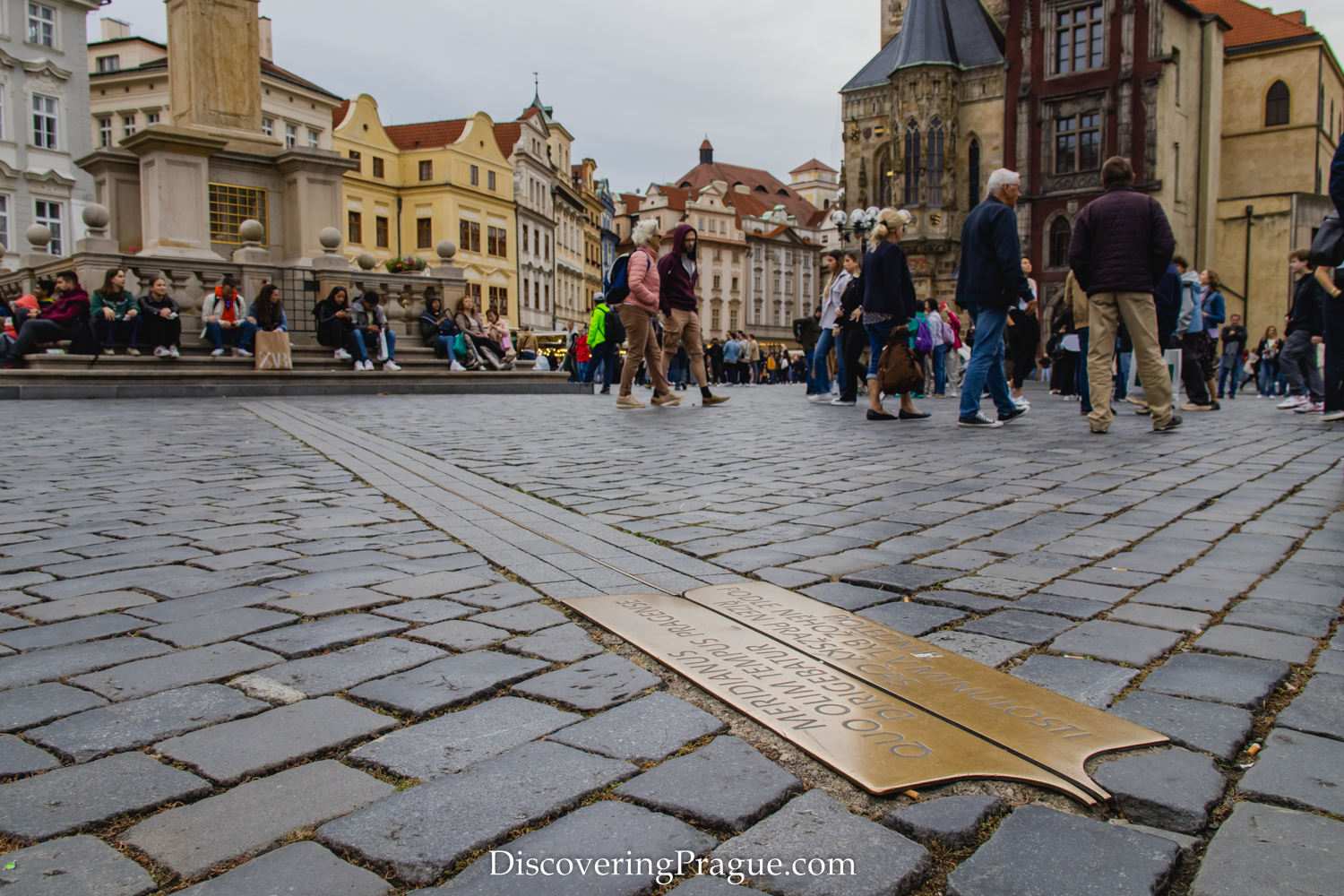
36) Church of Our Lady of the Snows
The Church of Our Lady of the Snows, or Kostel Panny Marie Sněžné, is a stunning place of worship that beckons visitors to explore its beautiful interior. Located near Wenceslas Square, the church’s ornate decor, intricate altars, and captivating frescoes make it a sight to behold. Actually, you can find there the highest column altar in Prague. There are regular roman catholic masses every day.
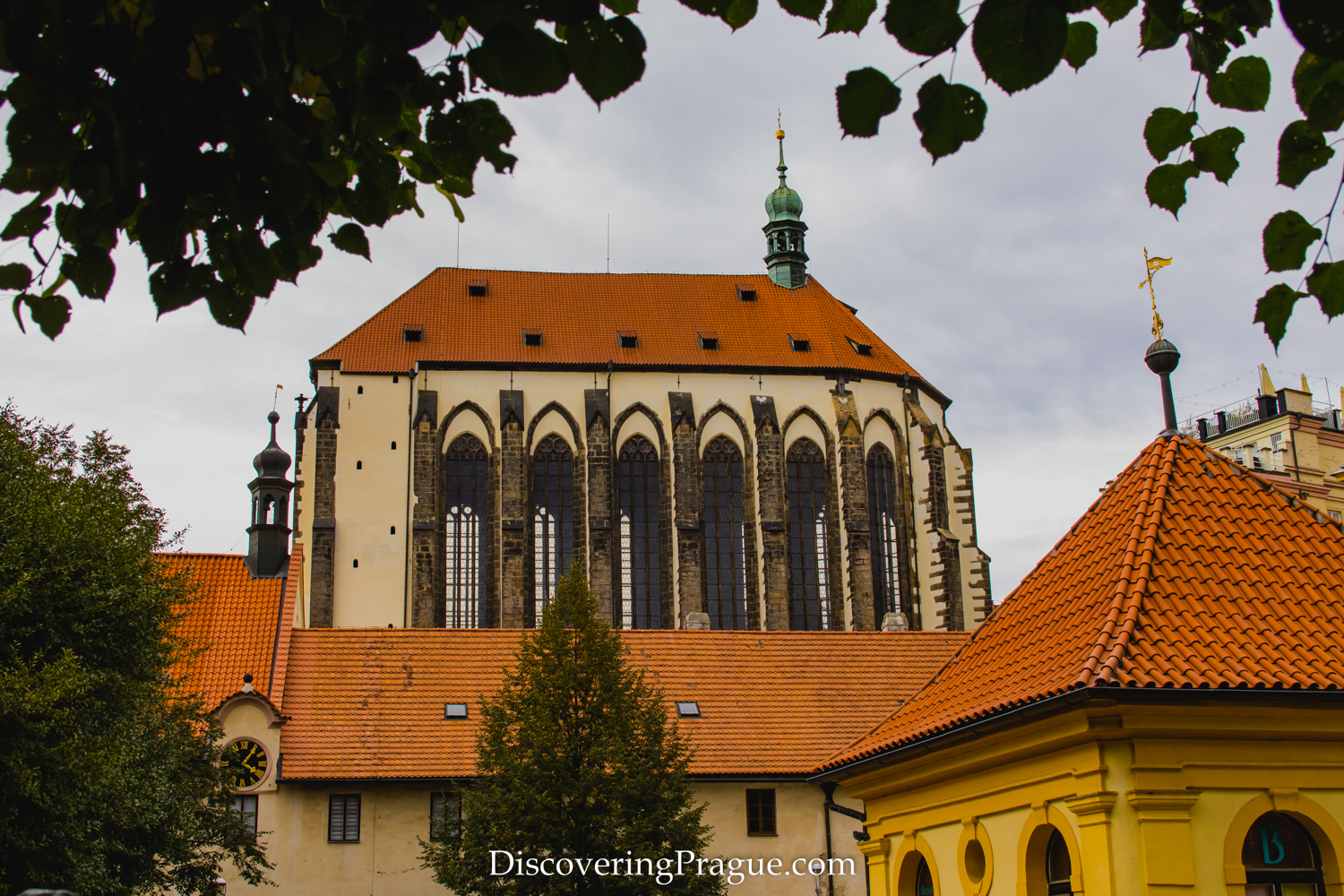
37) Vinohrady District
The Vinohrady District is a picturesque neighborhood in Prague that invites visitors to take a leisurely stroll and discover its charms. Take a chance to walk through this delightful district, characterized by tree-lined avenues, elegant Art Nouveau architecture, and a vibrant local atmosphere.
Vinohrady is known for its peaceful parks, inviting cafes, and diverse culinary scene. Whether you’re exploring the neighborhood’s green spaces, admiring its architectural heritage, or savoring a cup of coffee at a neighborhood cafe, Vinohrady offers a relaxed and authentic Prague experience away from the tourist areas.
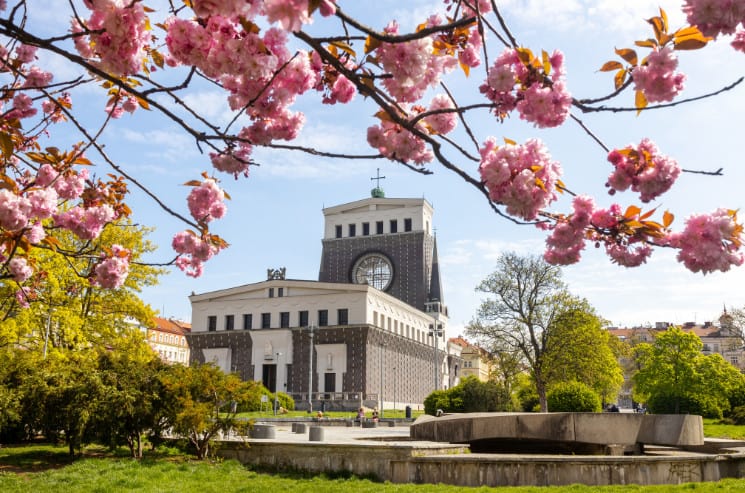
38) The Park of Brutalist Miniatures
Klárov Park, nestled near Prague Castle, offers a picturesque green space for relaxation and leisure. You can also discover Brutalist Miniatures by Kryštof Kintera. You may be surprised to learn that all the models are already broken – and it’s not the vandals’ fault this time – Kintera himself wanted to draw attention to the fragility of architecture by targeted destruction. The miniatures are interestingly illuminated during the evening.
39) Břevnov Monastery
Founded in 993 AD, the Břevnov Monastery is the oldest Benedictine monastery in the Czech Republic.
The monastery complex includes the Basilica of St. Margaret, a Baroque structure with a stunning interior that features frescoes and ornate decorations. The monastery grounds also contain a beautiful garden, a brewery that continues a centuries-old tradition, and the Vojtěška, a building that houses a unique wooden model of the Holy Land.
The monastery is open to the public year-round, but the experience is particularly enriching when you can attend one of the liturgical services or concerts held in the basilica.
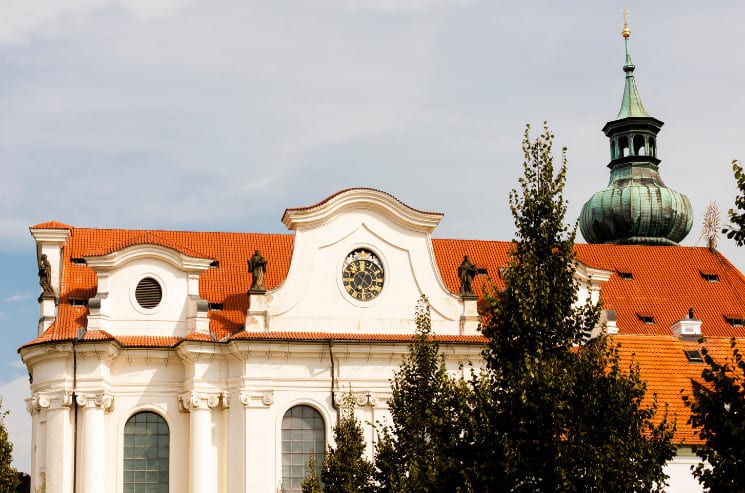
40) Hunger Wall on Petřín Hill
Stretching from Újezd towards the Strahov Monastery and beyond, the Hunger Wall was commissioned by the Czech King and Holy Roman Emperor Charles IV.
The wall is an imposing structure made of stone, and it offers a glimpse into the medieval defensive systems of Prague. While its primary purpose was defense, the wall also provided employment for the city’s poor during a period of famine, hence the name “Hunger Wall.”
Many paths cross the wall and you will find some nice views from these crossings.
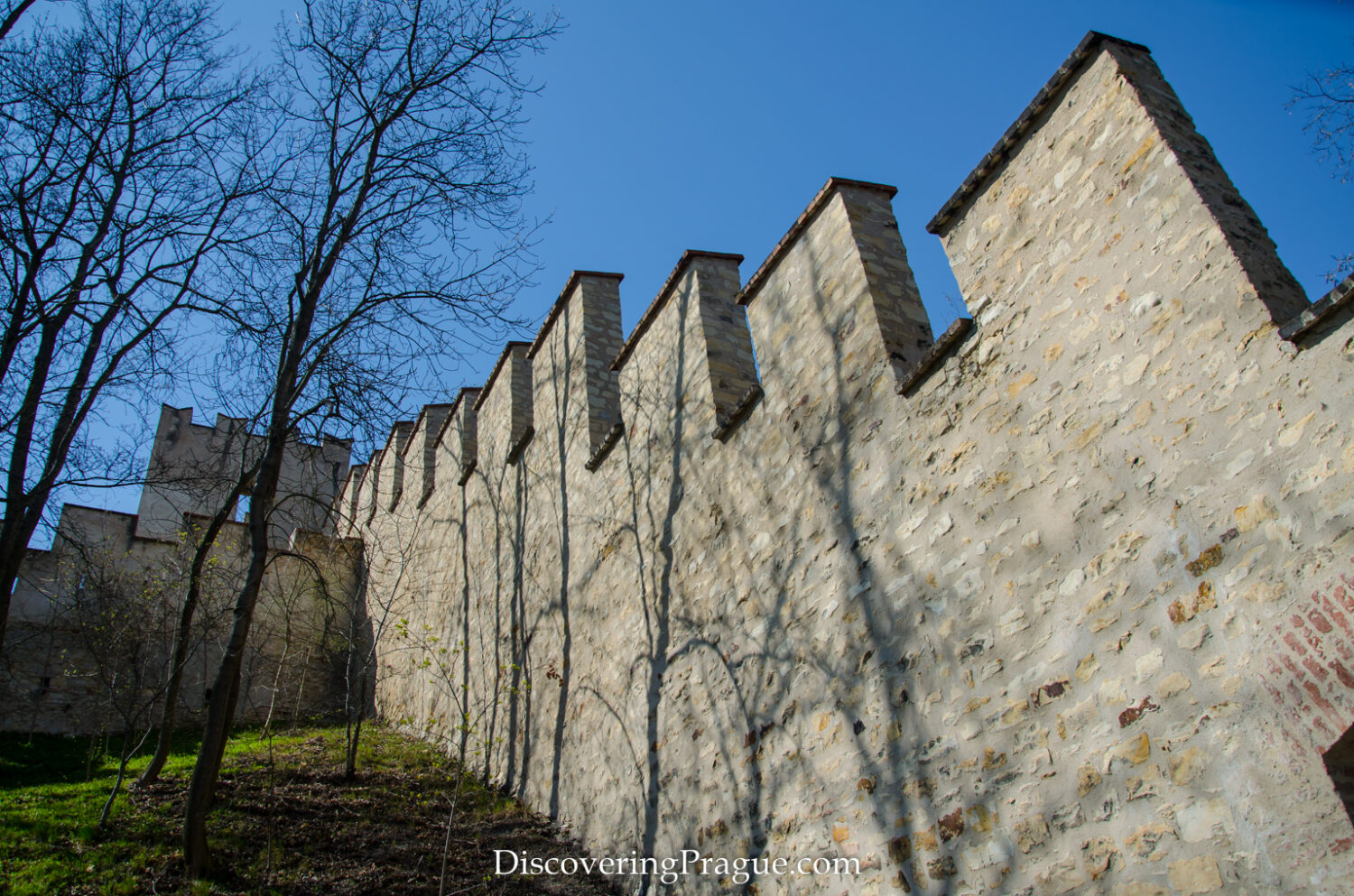
41) Přívozy – Prague Little Ferry Boats
The way how to enjoy a cheap ferry tour at Vltava River is using our lovely little Přívozy (ferries). There are seven ferry routes available, with some operating year-round and others seasonally. Ferry routes connect various areas of Prague, including Prague 6, Troja, Podolí, and Zlíchov. The best about it that they are part of the PID, which is system of public transport in Prague, so they are super cheap (1-2 euro). You can find timetables here.

42) Passage Světozor
Located in the heart of Prague, Pasáž Světozor has been connecting Vodičkova Street and Františkánská Garden since 1947. There are many passages like this, so this can be a nice example of how they look like.
Světozor was designed by architect Osvald Polívka with a facade by Josef Sakař, and the building itself is a blend of late Art Nouveau and emerging modern styles. One of the most eye-catching features is the typical mosaic logo of the Tesla company (not the Elons one).
Once you are there, visit Ovocný Světozor – the famous Sweet shop with delicious desserts and our traditional chlebíčky (open-faced sandwiches).

43) Go for a walk in Divoká Šárka Nature Reserve
Divoká Šárka offers a natural escape on the outskirts of Prague, providing an opportunity to immerse yourself in the beauty of this little “wilderness”. Nestled in the Šárka Valley, this protected area features lush forests, meandering streams, and rugged cliffs. A network of walking trails allows outdoor enthusiasts to discover an untamed side of Prague, an ideal place for a peaceful retreat from the urban environment.
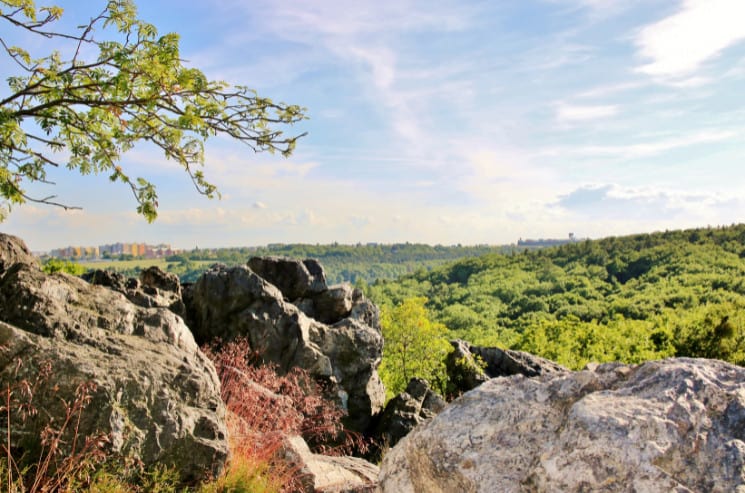
44) Kinský Garden
Kinský Garden is a charming park located near Petřín Hill, offering visitors the chance to explore its beautiful surroundings – green space, complete with manicured lawns, tree-lined paths, and scenic views. The garden’s serene ambiance makes it a perfect spot for a leisurely stroll, a family picnic, or simply a moment of relaxation. Kinský Garden is a tranquil escape from the city’s bustle, providing a peaceful retreat within Prague’s urban landscape.
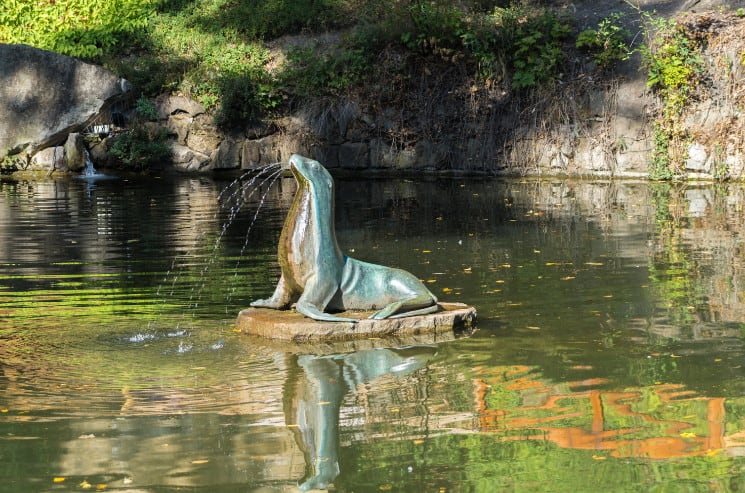
45) Celtic oppidum Závist
The Keltské oppidum Závist is the largest known Celtic oppidum in the Czech Republic and Central Europe. It is located on the Hradiště hill, also known as Závist, near Zbraslav in Prague. The oppidum was built around 180 BC and the fortified area exceeded 100 hectares. The inner structure of the “town” included courtyard buildings, houses with solid structures, workshops, and storage spaces. The entire oppidum was abandoned between 30 and 20 BC. The ideal way to explore the Hradiště is through the Oppidum Závist educational trail, which introduces visitors to the suburb, gates, fortifications, and acropolis.
46) Historical mikveh at the Pinkas Synagogue
The historic mikveh located next to the Pinkas Synagogue in Prague is one of the oldest examples of Jewish settlement in the area. It is believed to date back to the early 16th century. The mikve is a Jewish ritual bath, consisting of a pool of natural water, traditionally used for the ritual purification of people and objects in Judaism.
The mikveh was discovered during an archaeological survey in 1968 and is located in the basement of the building next to the Pinkas Synagogue. It is open to visitors as a part of the Jewish Museum, which also includes the Pinkas Synagogue and other historic Jewish sites in the city.
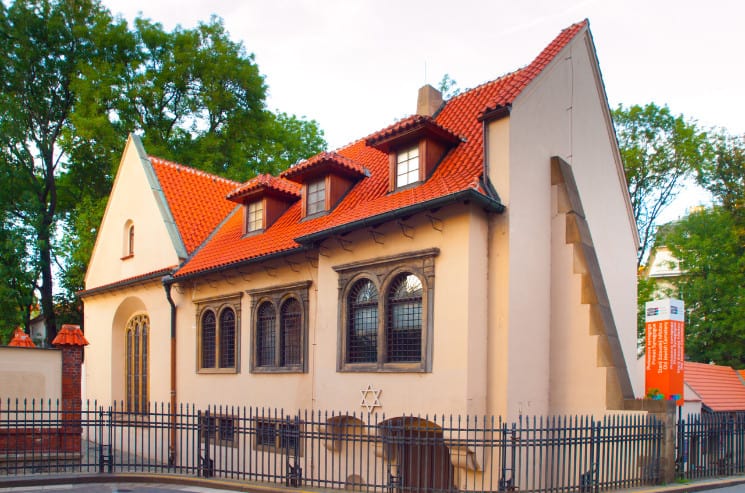
47) Church of St. Martin in the Wall
The Church of St. Martin in the Wall, located in the Old Town of Prague, is another example of medieval architecture, with its Romanesque and Gothic elements still well-preserved today.
Situated near Národní třída, the church is easily accessible. It was built between 1178 and 1187 in the village of Újezd, which was later divided between the Old and New Towns.
The church is open Guided tours are available, providing additional insights into the church’s history.

48) Karlín: Stroll through a trendy neighborhood
Karlín is a trendy and up-and-coming neighborhood in Prague, perfect for a leisurely stroll and exploration. This district is known for its charming streets, eclectic architecture, and burgeoning culinary scene. As you wander through Karlín’s streets, you’ll encounter stylish cafes, chic boutiques, and a welcoming local vibe. It’s an ideal neighborhood to discover Prague’s modern side, away from the tourist crowds.
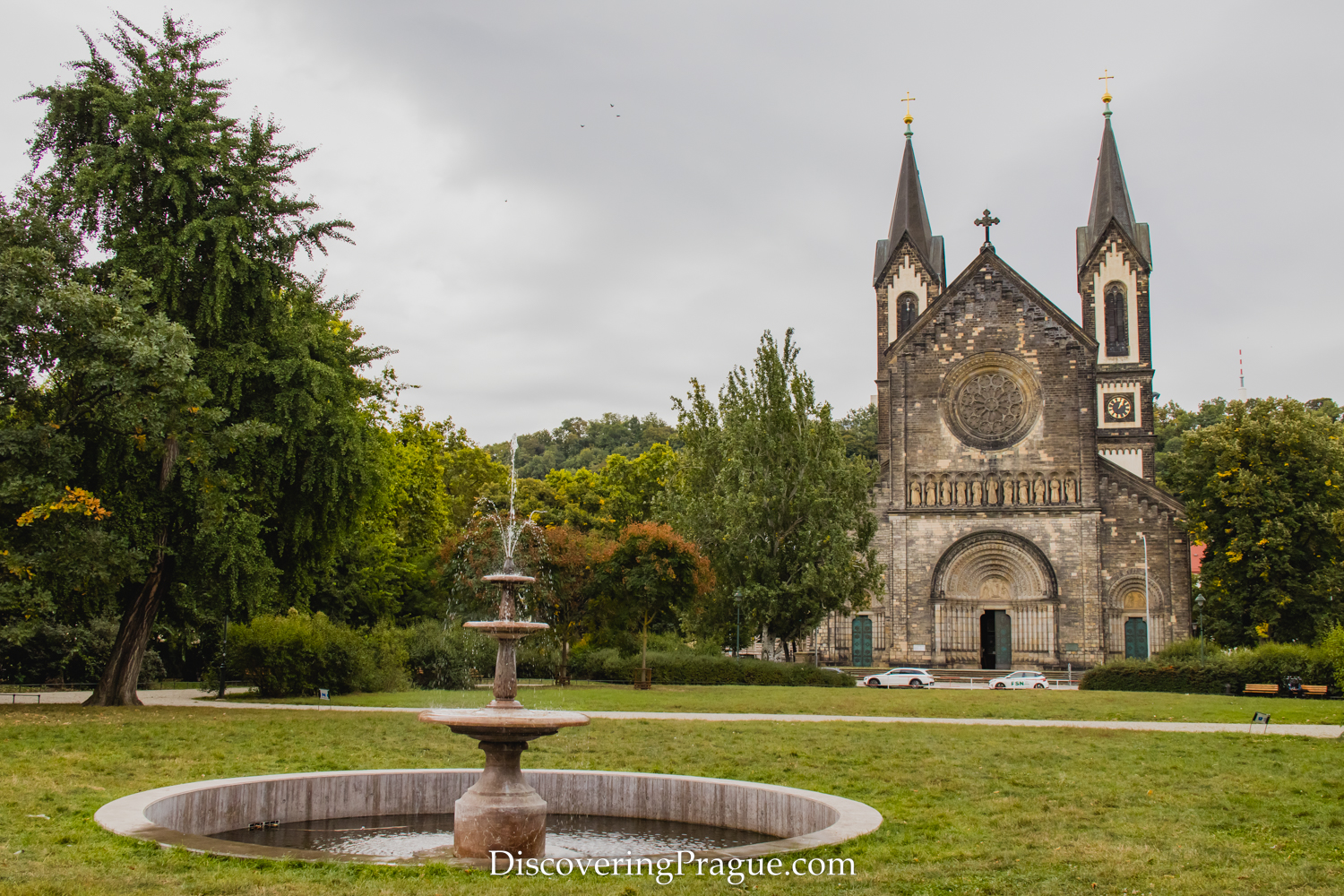
49) Gabriel Loci
Gabriel Loci is a unique complex located in Prague 5, near the Kinsky Garden. It was built in the Neo-Romanesque style between 1888 and 1891 and is remarkable for its artistic decoration in the style of the Beuron School of Art.
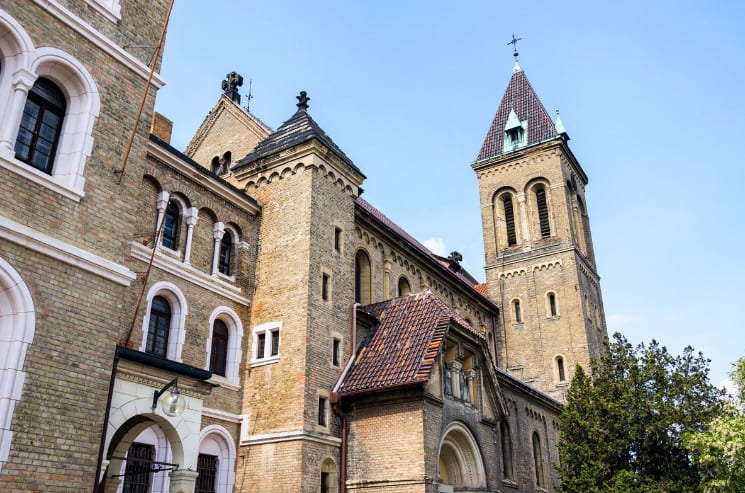
50) Church of St. Cyril and Methodius: Learn about Operation Anthropoid
This is something for history lovers. The Church of St. Cyril and Methodius offers the opportunity to learn about WWII Operation Anthropoid. This church once served as a refuge for Czechoslovak paratroopers who carried out the daring assassination of Reinhard Heydrich (a high-ranking Nazi official).
You can explore the church’s interior, where a memorial now stands in their honor. It’s a place to reflect on the courage and sacrifice of those who fought against oppression, adding depth to your understanding of Czech history.
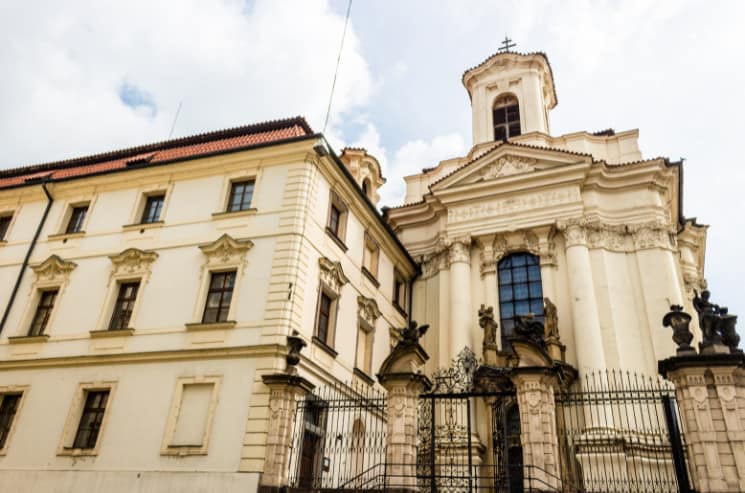
51) National Marionette Theatre
The National Marionette Theatre is renowned for its performances of world-famous works like “Don Giovanni,” “The Magic Flute,” and “The Magical Theater of the Baroque World – Orfeo ed Euridice.”
The theater’s repertoire is rich and varied, featuring almost daily performances. Each show is accompanied by a puppet exhibition that enhances the atmosphere and allows the audience to appreciate the craftsmanship involved. The theater also offers workshops where you can try your hand at creating your own Art Deco-style puppet.
Performances are held almost daily, making it easy to fit a visit into your schedule. However, popular shows like “Don Giovanni” often sell out, so it’s advisable to book tickets in advance.
52) Vyšehrad
Vyšehrad, often referred to as “the second castle of Prague,” holds a special place in Czech mythology and history. The fort is home to the Basilica of St. Peter and St. Paul, a neo-Gothic church with stunning murals and a beautiful cemetery, where many famous Czech personalities are buried. The area also features statues, gardens, and remnants of the original fortifications. One of the most popular spots is the lookout point offering panoramic views of Prague and the Vltava River.

53) Thunovská street
Located in the heart of Malá Strana, Thunovská Street is a charming, cobblestone street lined with beautiful Baroque and Renaissance buildings. Many of which have been converted into boutique hotels, cafes, and galleries. The street is also home to several embassies, adding an international flair to the area.
Pay attention especially to one imposing feature which is a connecting corridor with a vaulted arch between the buildings.

54) Olšany cemetery
Olšanské hřbitovy is the largest graveyard in Prague and one of the largest in Europe. The cemetery is divided into several sections, each with its own character and historical significance.
It features a variety of architectural styles, from Gothic to Art Nouveau, reflected in the tombstones, mausoleums, and chapels.
The cemetery is also known for its lush greenery, making it a peaceful place for a reflective walk. It’s particularly atmospheric during the autumn months when the leaves are changing colors. And especially around the “Dušičky” (celebrated on 2nd November), which is All Souls Day.
55) Visit VNITROBLOCK
This place is a cool “hipster” area, with cafés and art galleries, in my point of view. The space is designed to be versatile, hosting a variety of events and functions. You can find there a café, a design shop, and an independent cinema. There is also a cool indoor courtyard, which serves as a communal area for socializing, working, or simply relaxing. More about VNITROBLOCK.
I hope that exploring these lesser-known corners of Prague brings you joy and new perspectives.

56) The Aviation Museum Kbely
Founded in 1968 in the historic area of Prague-Kbely, the first military airfield established after Czechoslovakia’s creation in 1918, the museum stands as one of Europe’s largest air museums, owing to the quantity and quality of its collections. It houses 275 aircraft, with 85 on public display, and features many unique world-class exhibits, including one-of-a-kind Czech plane constructions and both types of the Me 262 Schwalbe.
The museum focuses primarily on the history of Czech and Czechoslovak aviation, particularly the military sector, but also features significant foreign aircraft and a range of aviation-related artifacts, including engines, uniforms, and marks of distinction.
The museum is open from May till October, Tuesday to Sunday from 10 AM to 6 PM Admission is free of charge.
To get to the museum take bus No. 185, 259, 280, 302, 375, 376 – 10 minutes from Letňany underground station (bus stop Letecké museum).
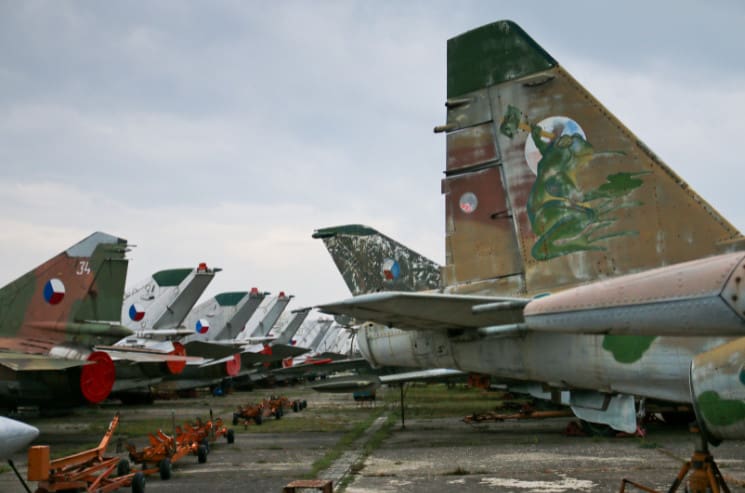
57) The Army Museum Žižkov
The Army Museum Žižkov features an extensive exposition, divided into seven main sections representing different historical periods of Czech military history, from the earliest times to the present. The museum, housing over seven thousand exhibits from the Military Historical Institute Prague, presents them across four floors and numerous showcases and halls, with some featuring mezzanines. The exhibit presentation, including lighting, utilizes the latest trends and advanced technology. A highlight includes “objects with a story,” giving insight into the object’s history and related individuals. Many exhibits also feature QR codes for visitors to access detailed information.
The museum is open every day except Monday from 10 AM to 6 PM.
58) The Gas Industry Museum
The Gas Industry Museum, located in Prague 4 – Michle, was opened in 1999 as the first museum of its kind in the Czech Republic. Visitors can explore the history and development of the global and Czech gas industry from its inception to the present day. The museum features period gas appliances, models of old production facilities, gasometers, and the construction of gas pipelines, among others. A reconstructed model of the Michle gas plant showcases its appearance in 1937, highlighting its historical connection to the city of Prague.
The date of the museum visit must be arranged in advance by calling +420 724 104 874 or by email: [email protected]. More information at PPAS.cz
59) Botanical Garden of Charles University
The Botanical Garden of Charles University serves as an oasis of tranquility and an embodiment of natural beauty and educational richness. Established by the university, this botanical garden is not just a showcase of diverse plant life but also a hub for scientific research, conservation, and environmental education. More information here.
60) The PRE Gallery and Museum (Power Industry)
The Technical and Documentary Museum of Prague Power Industry maps the rich history of electricity production, distribution and distribution from the beginning of the 20th century to the present day.
In the extensive exhibition on an area of almost 800 m2, fans from the professional and general public will find everything from very high, high and low voltage equipment to documents documenting the history of the electrification of Prague.
The PRE Gallery started its activity in 1998 in the operational building of the Prague Energy headquarters at 1492/4 Na Hroud Street. During its existence, more than one hundred and twenty interesting exhibitions of artists of renowned names and emerging talents have been held in the representative premises of the gallery.
The gallery is open on weekdays from 12 noon to 6 pm. The museum operates TUESDAY and THURSDAY from 8 am to 3 pm (always by appointment). More details here.
Pin Prague hidden Gems for later or for your friends:

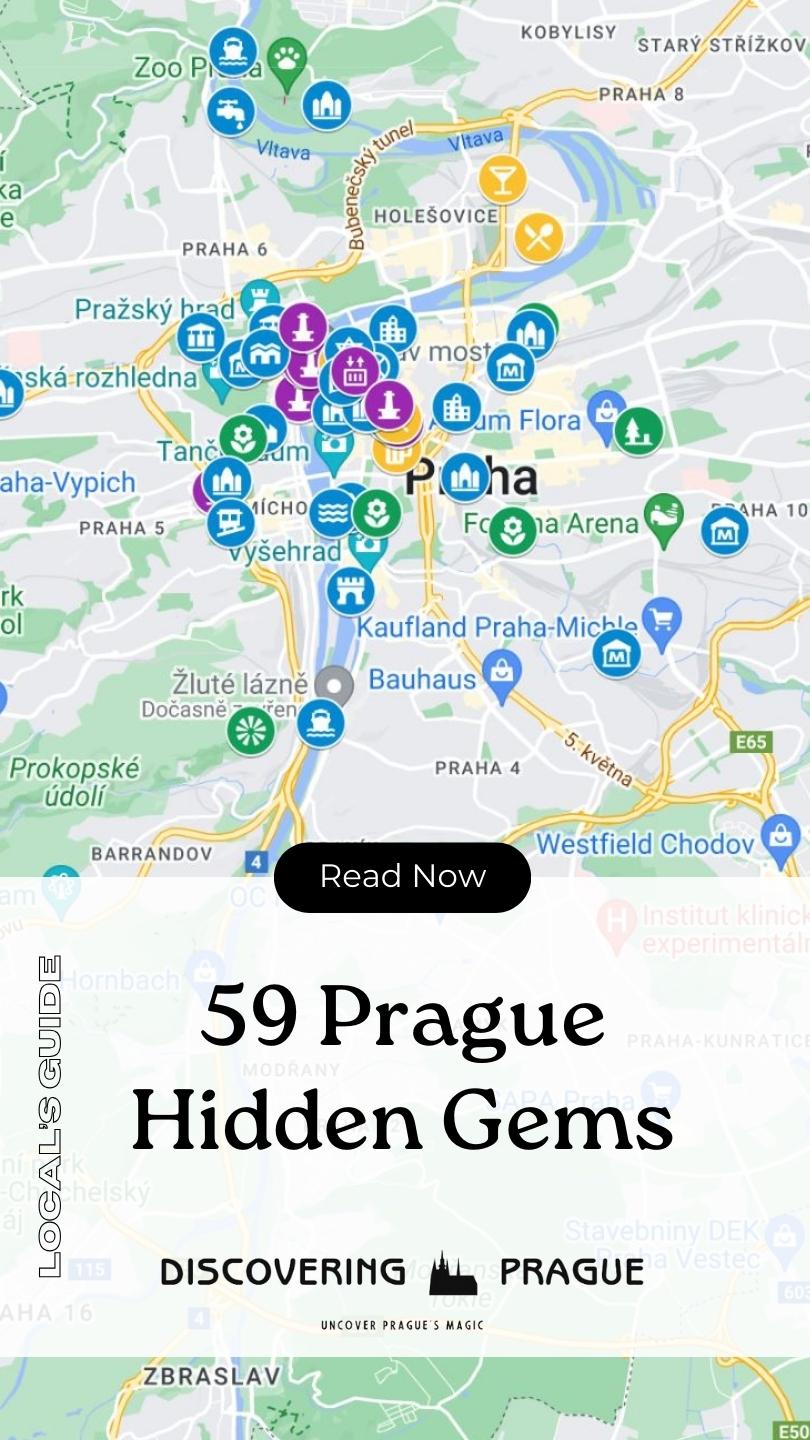
Did this post about non-touristy things to do in Prague help you? Share it with your friends! It can help the

